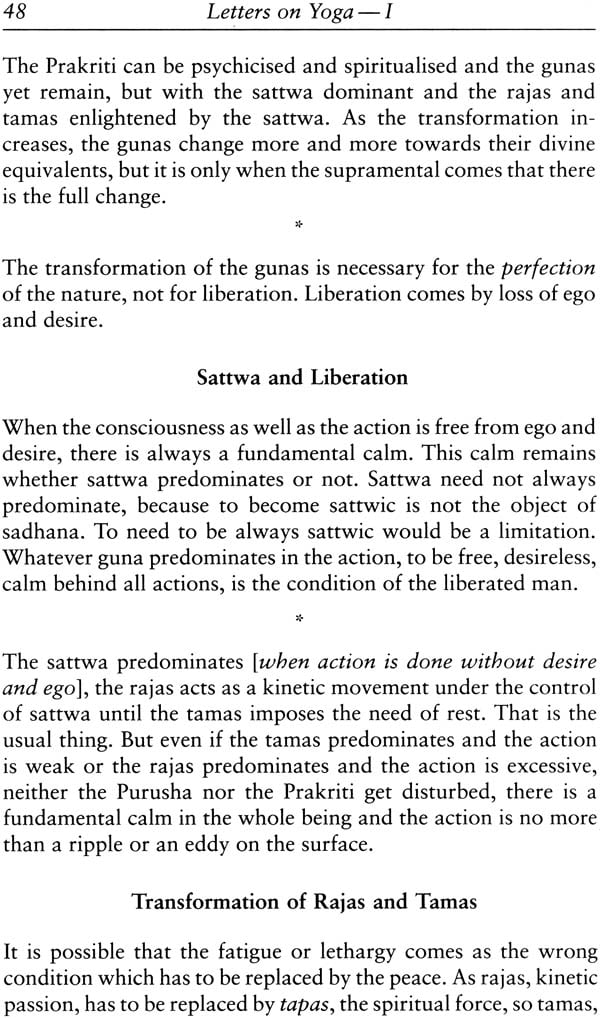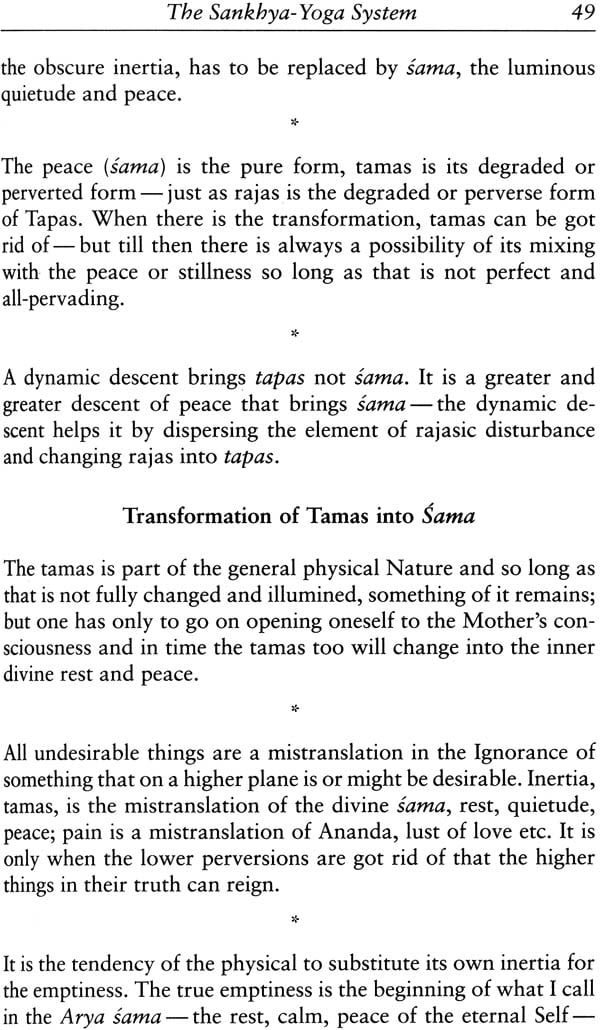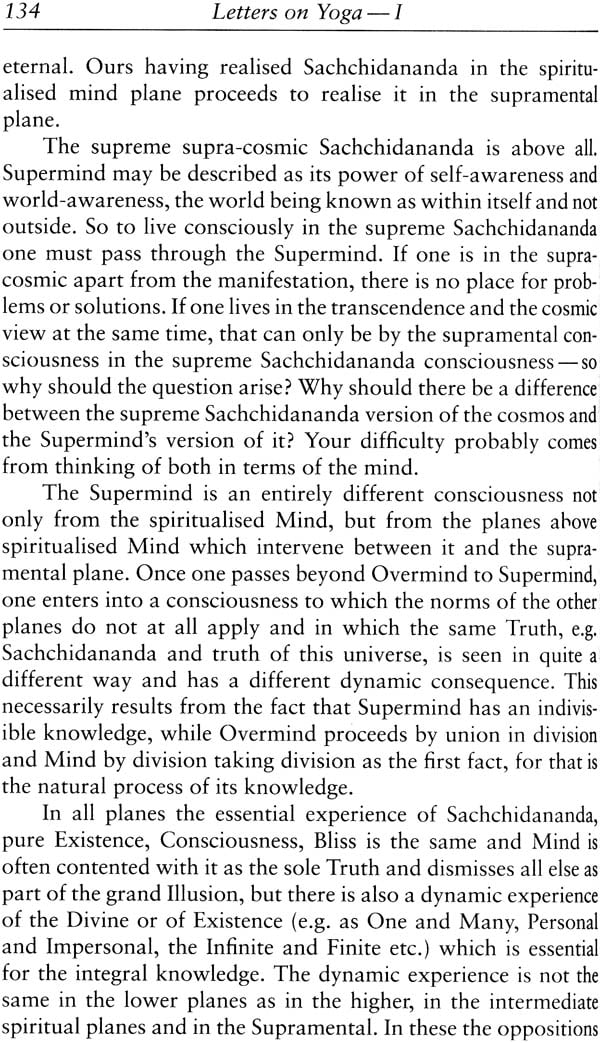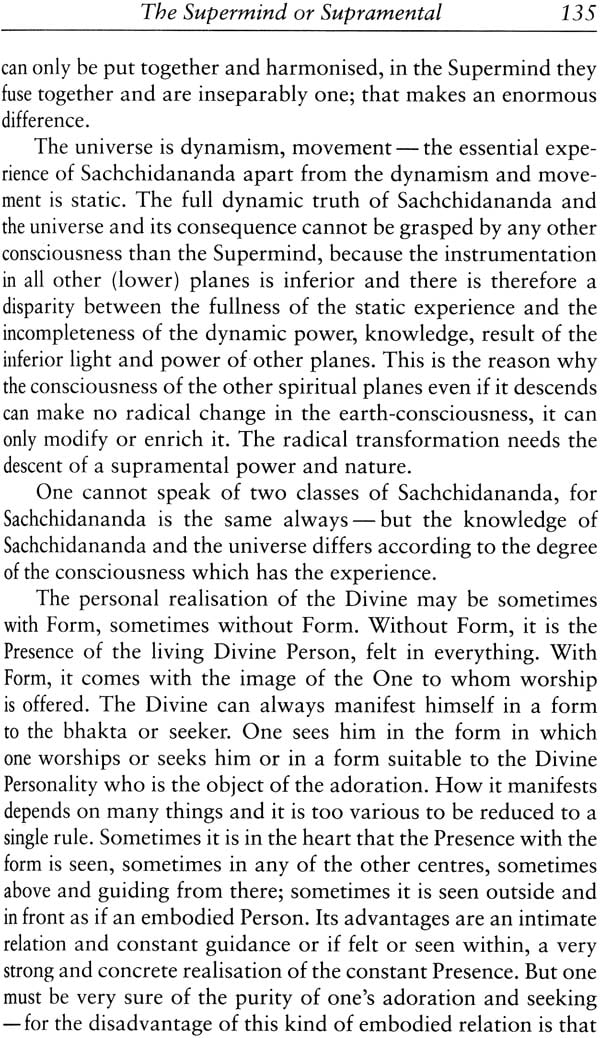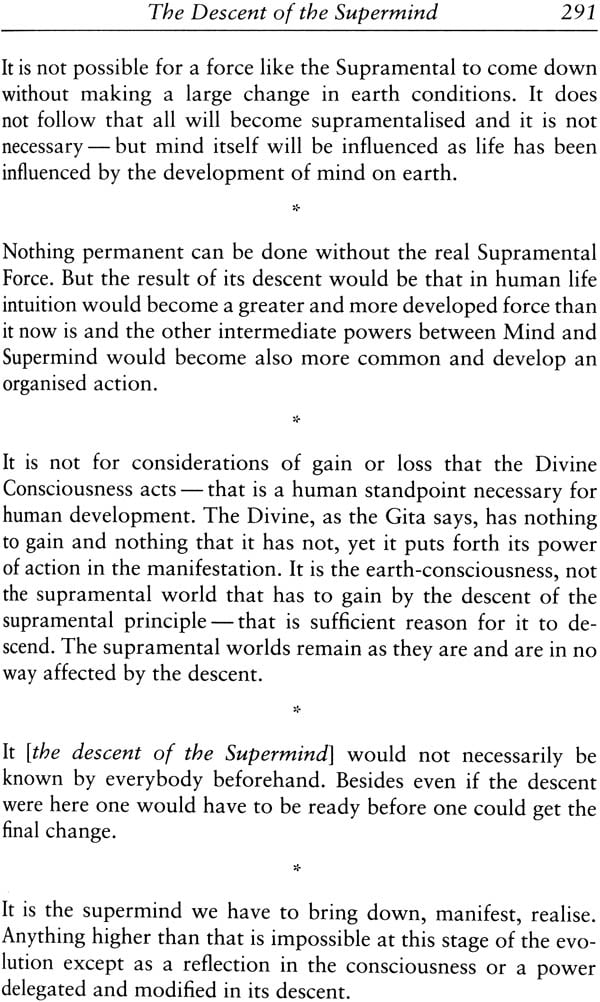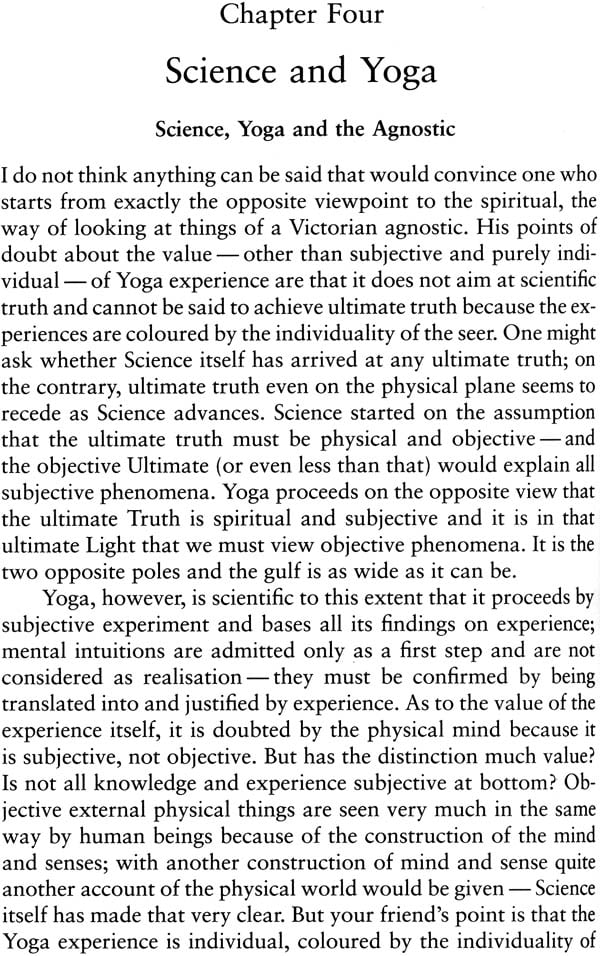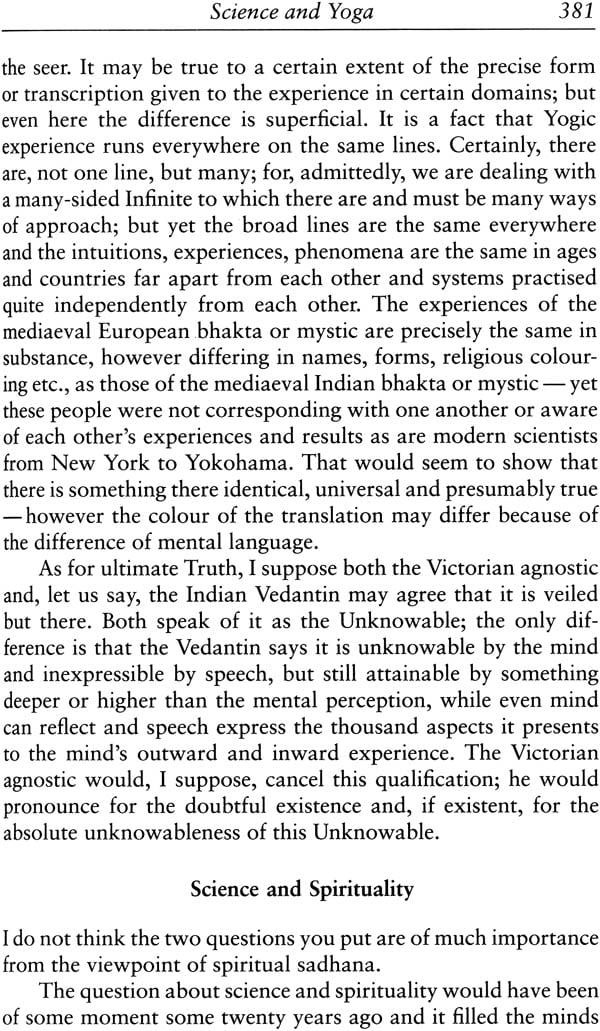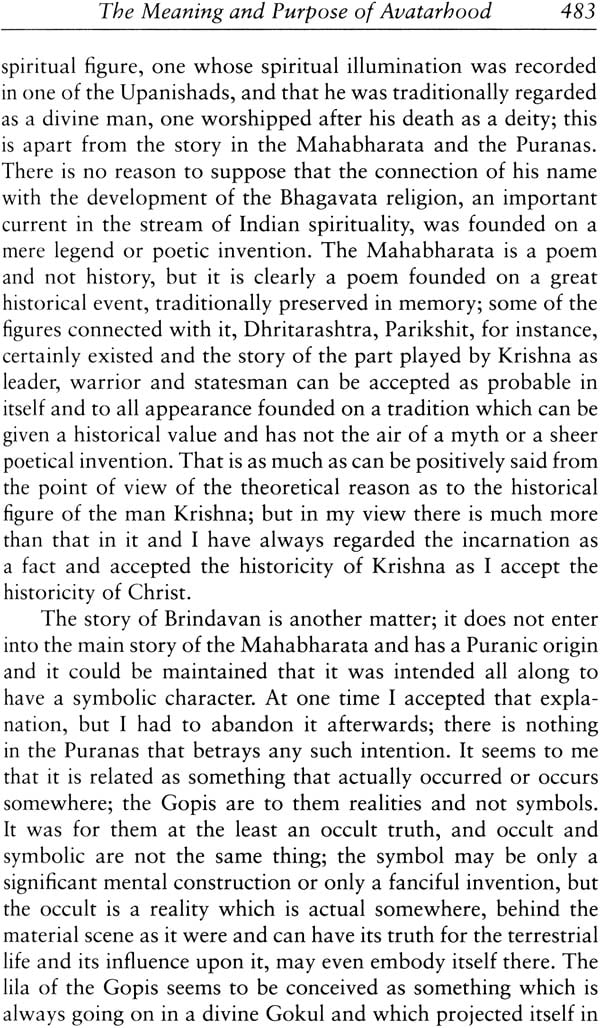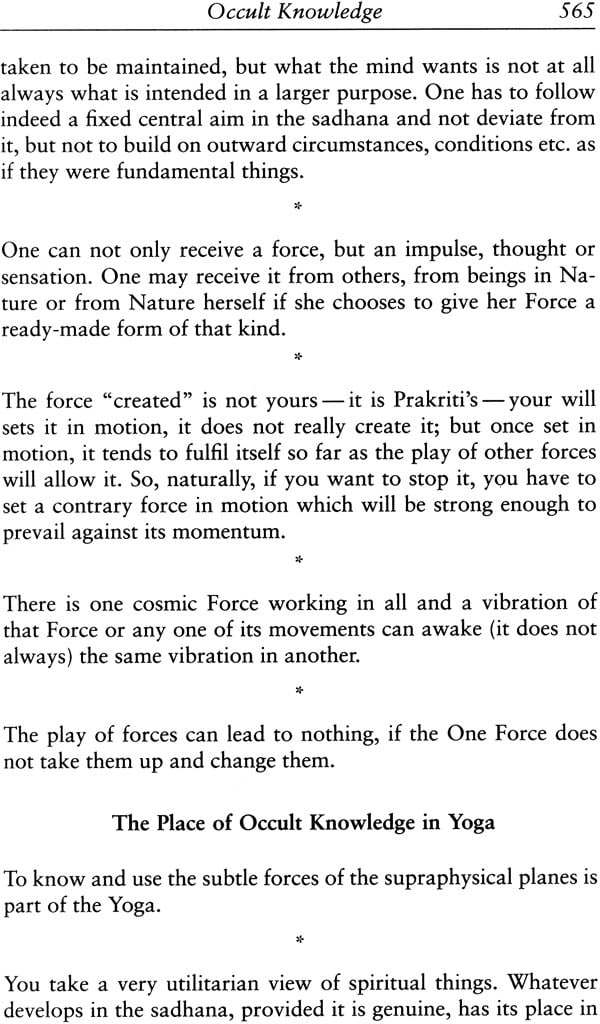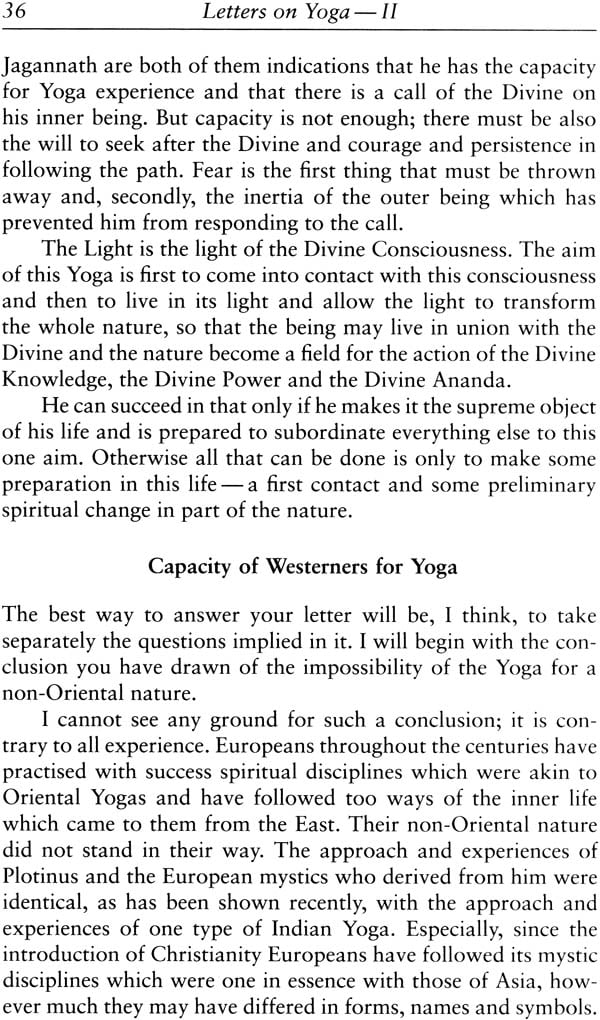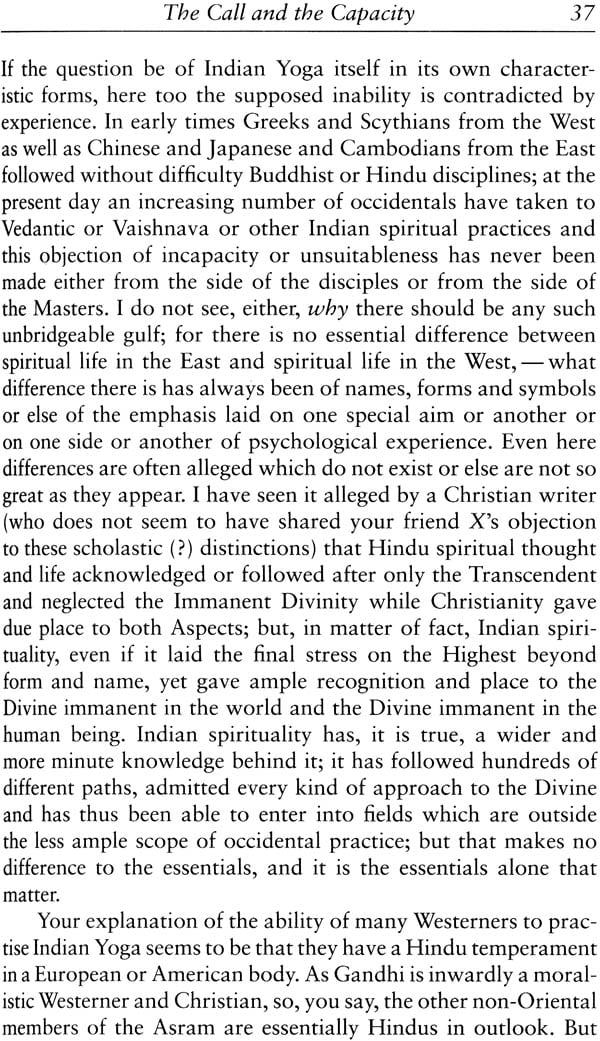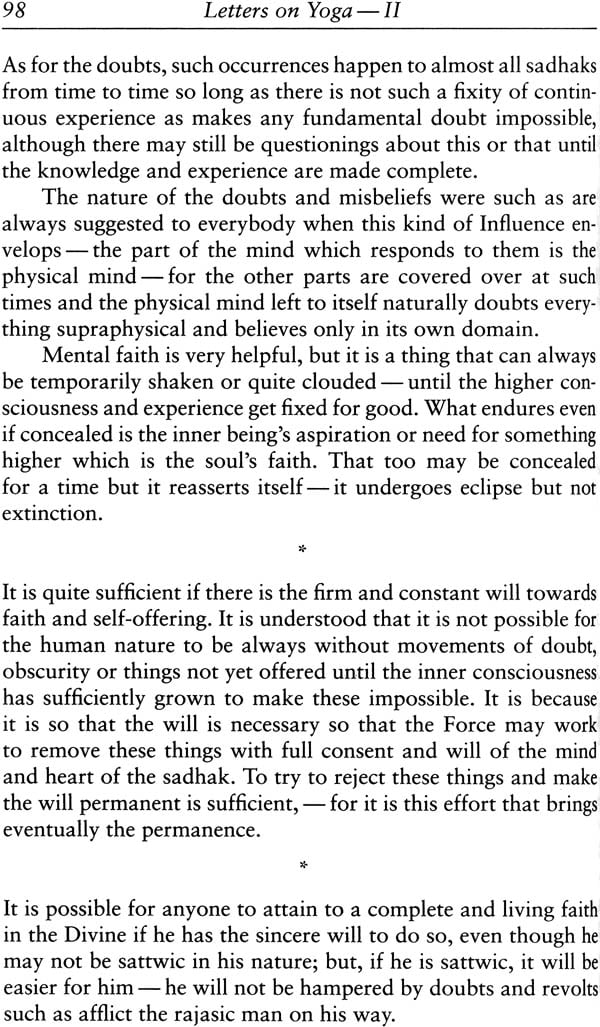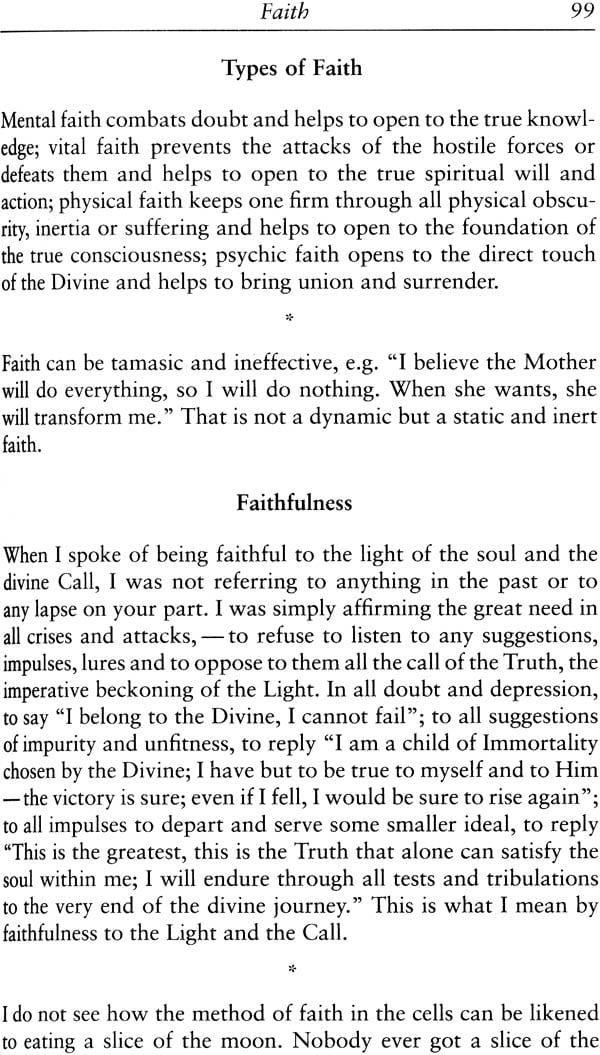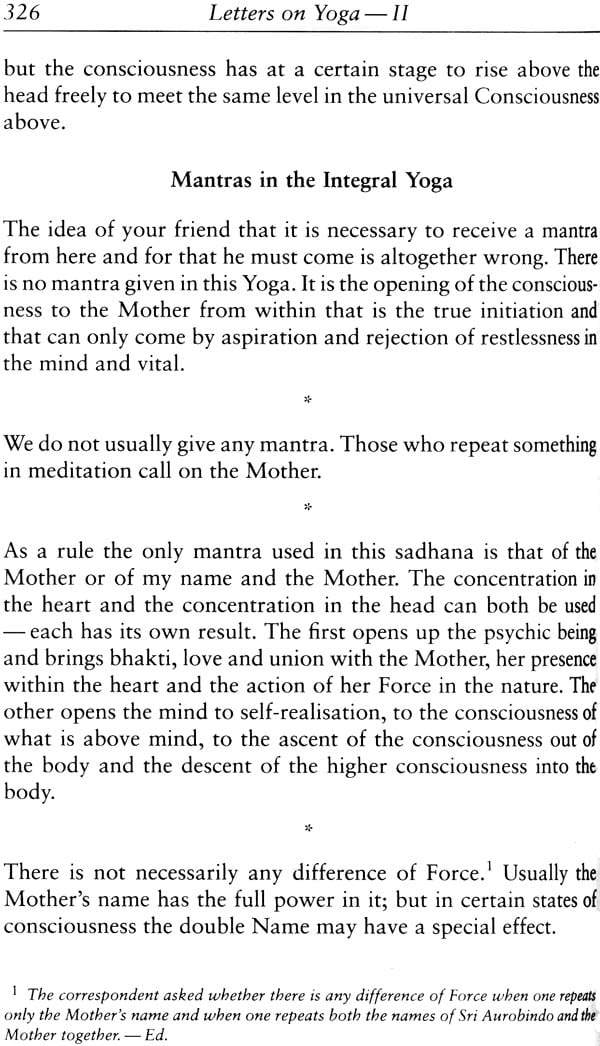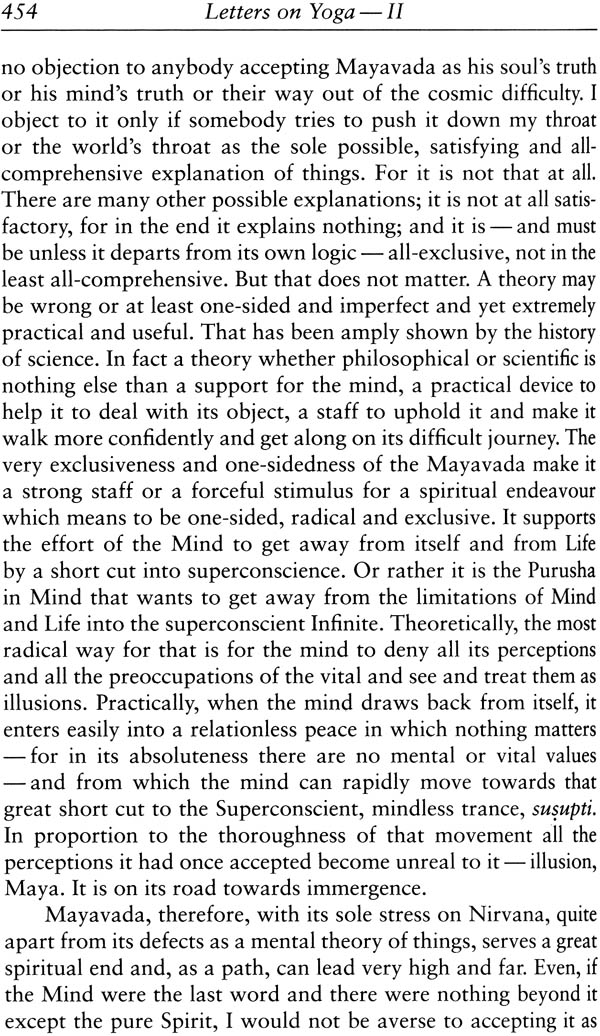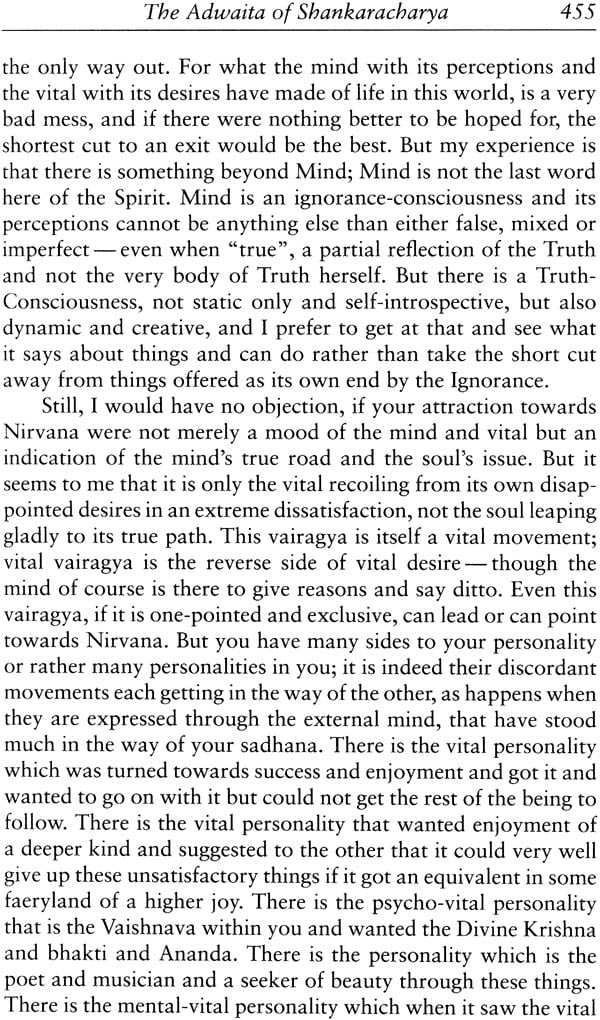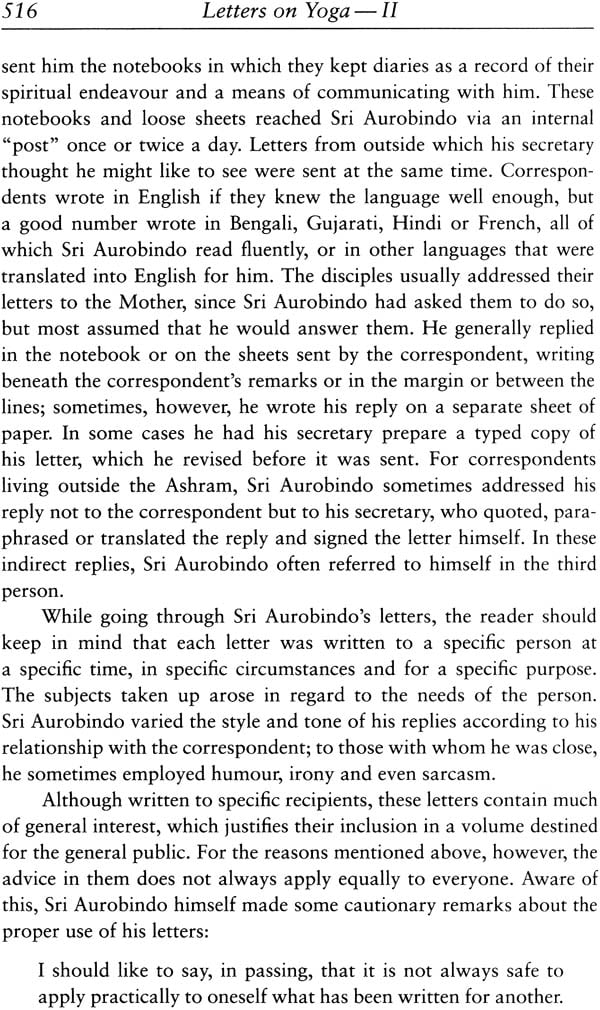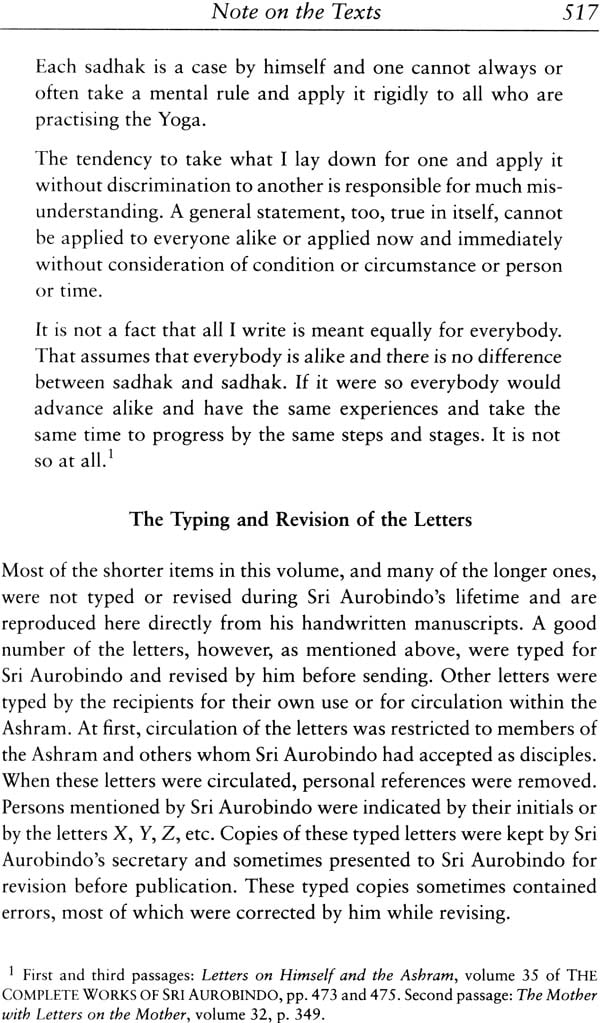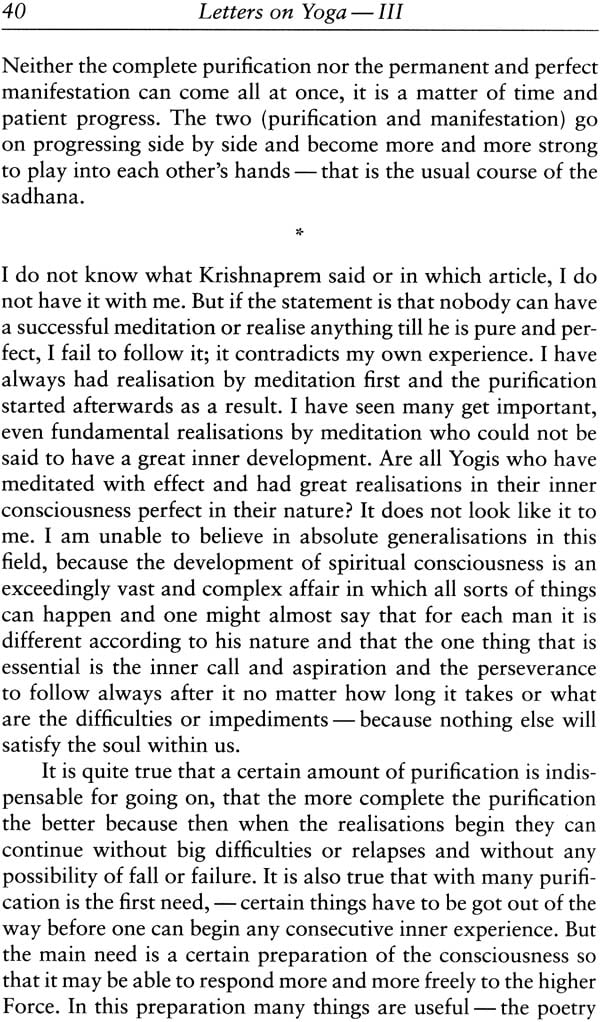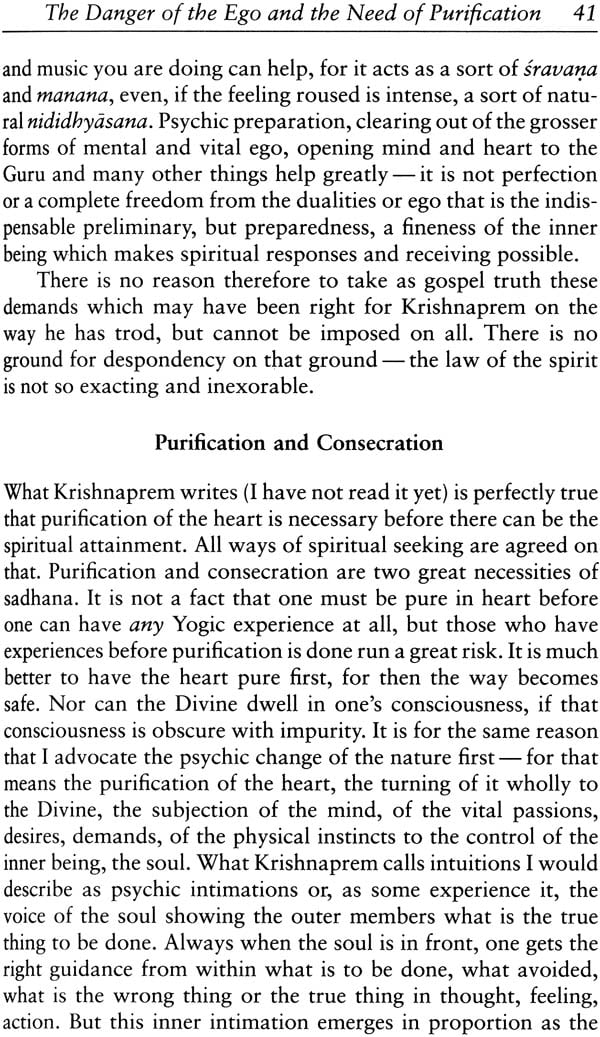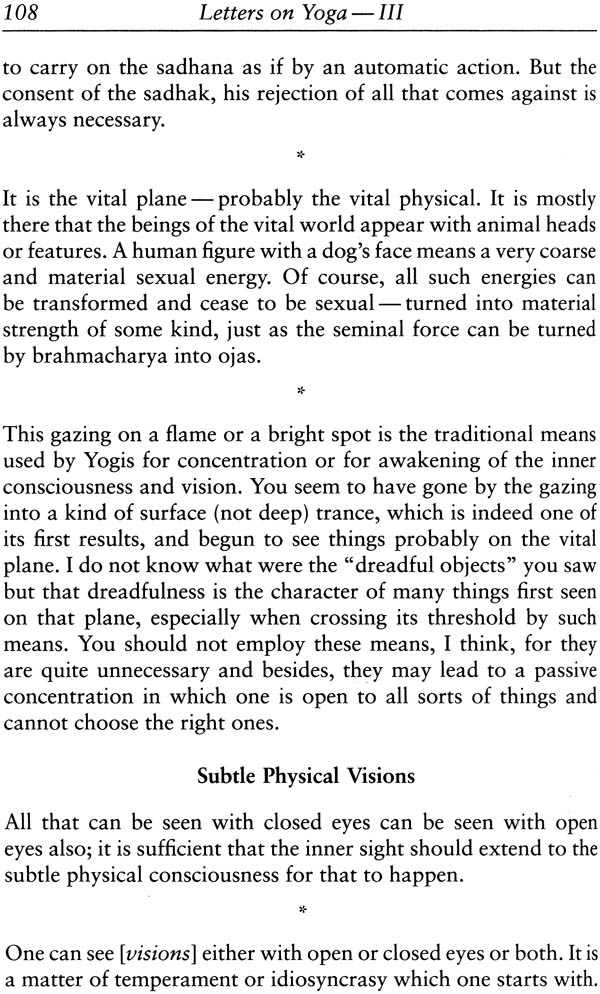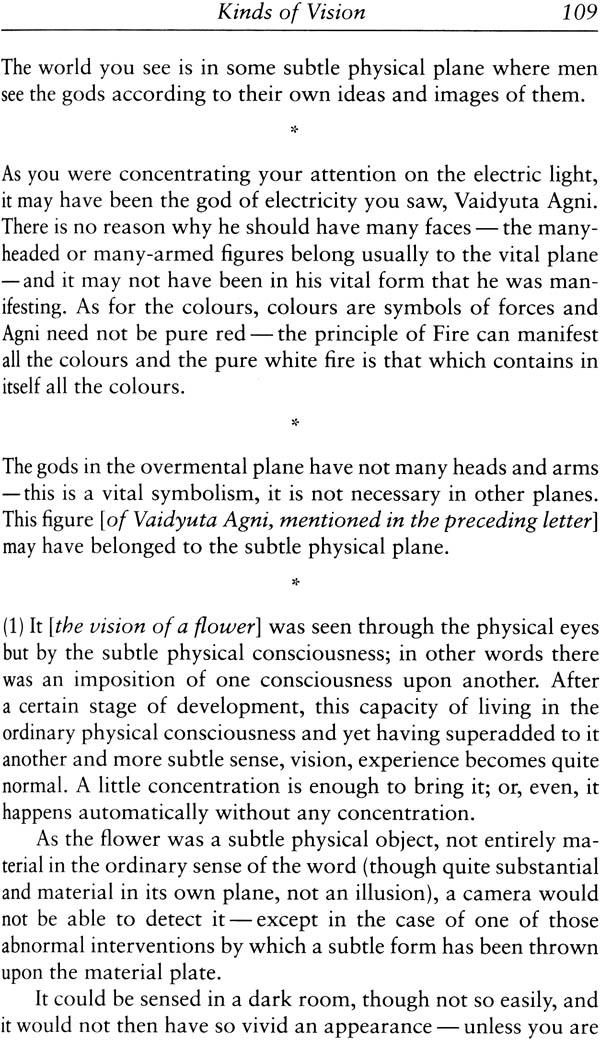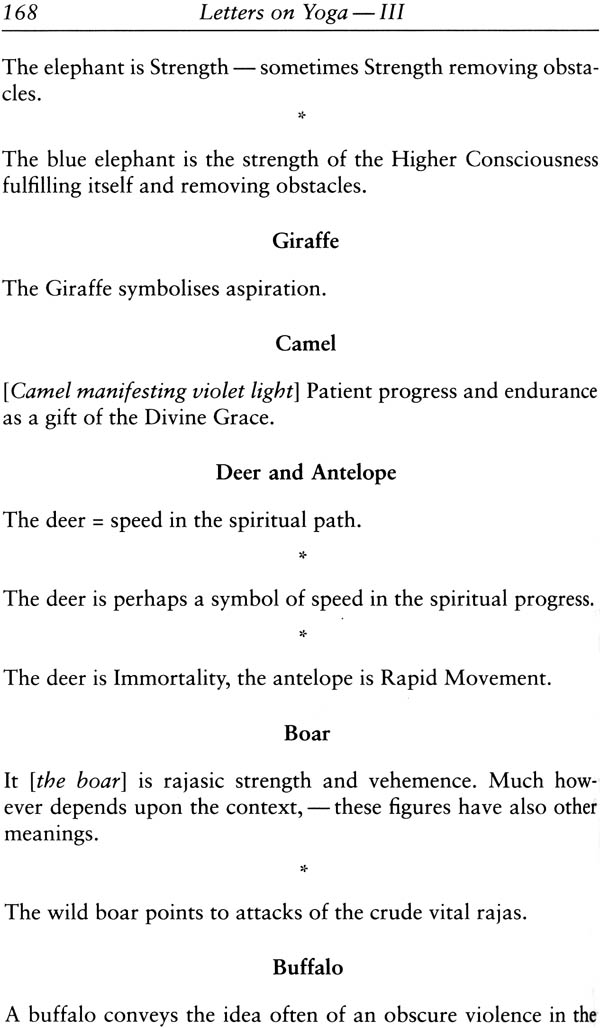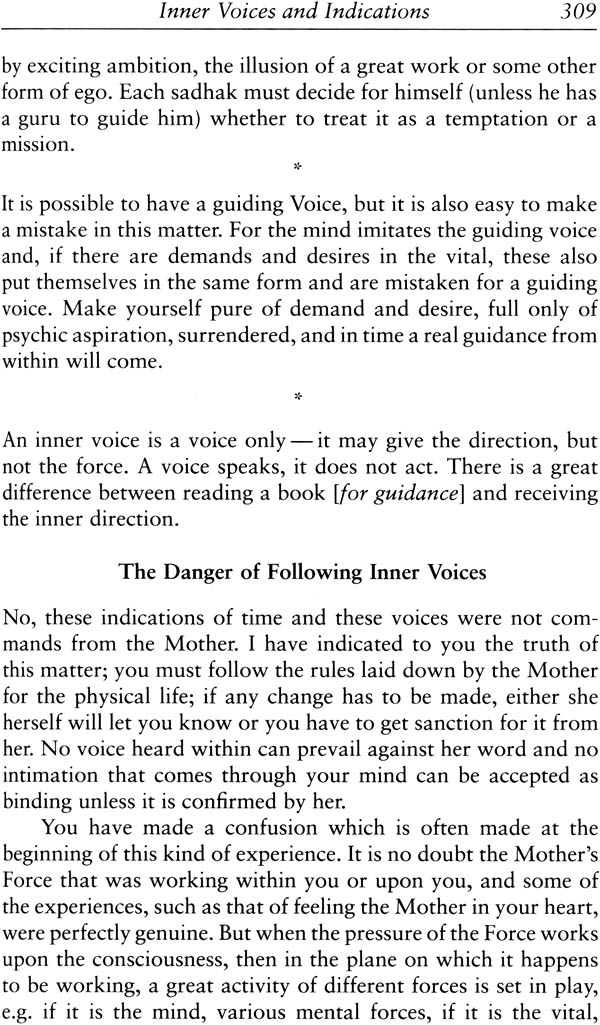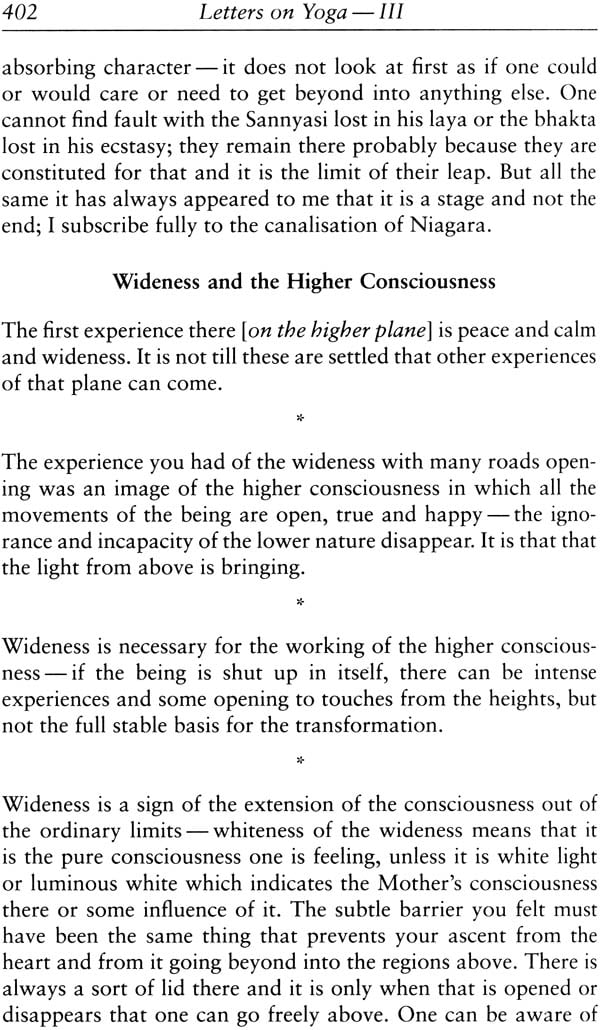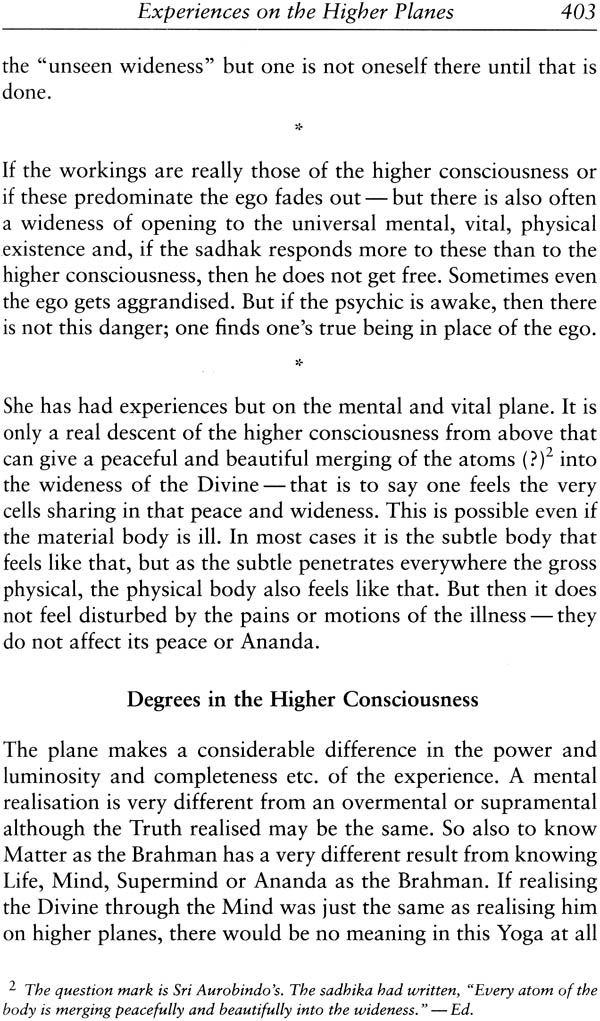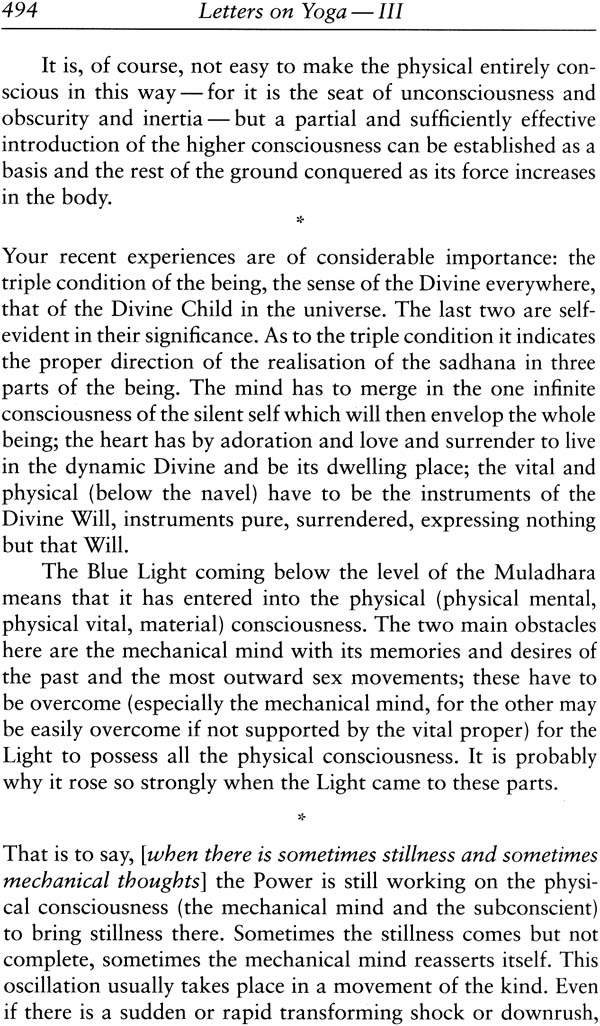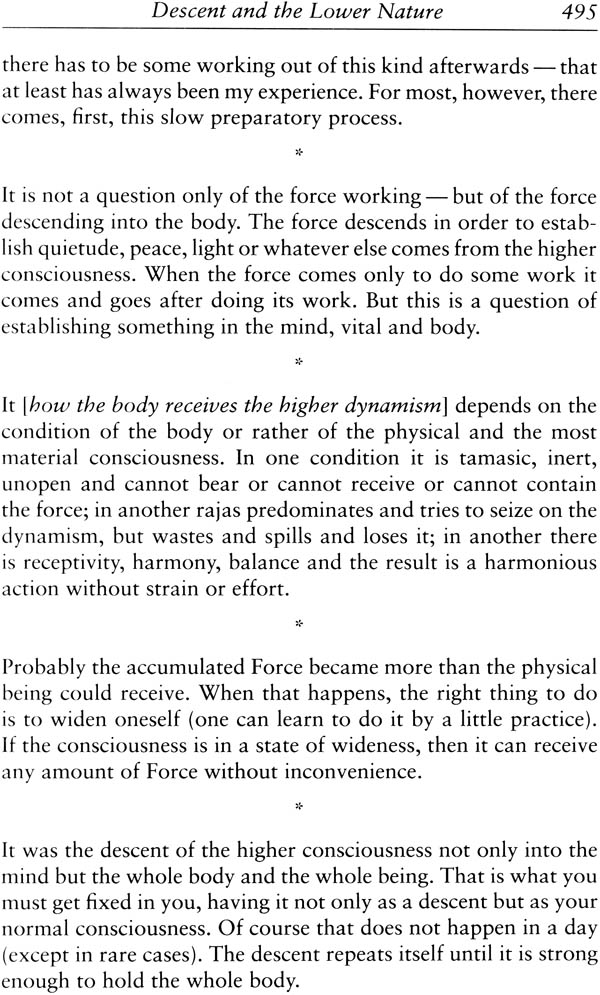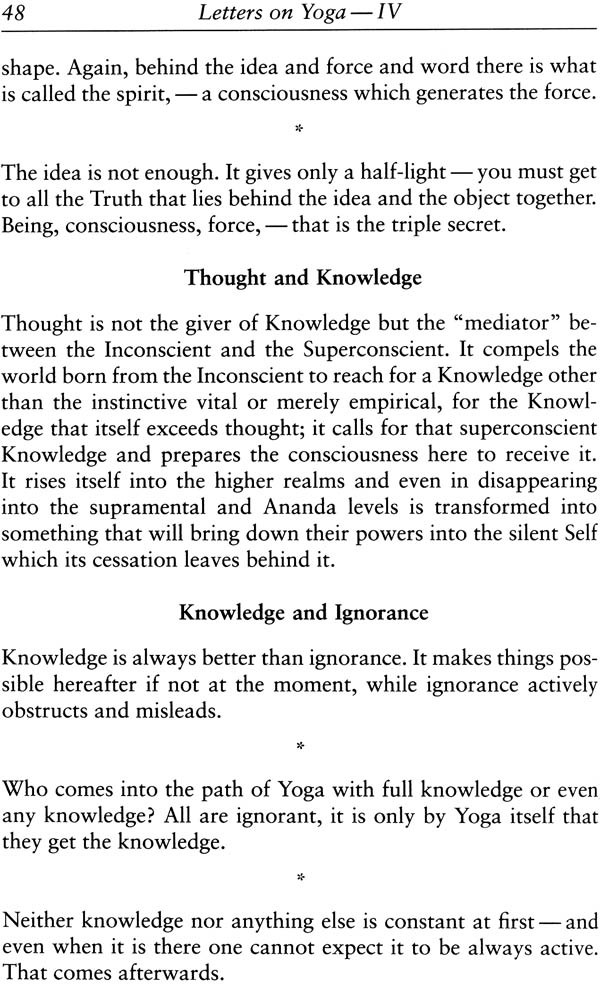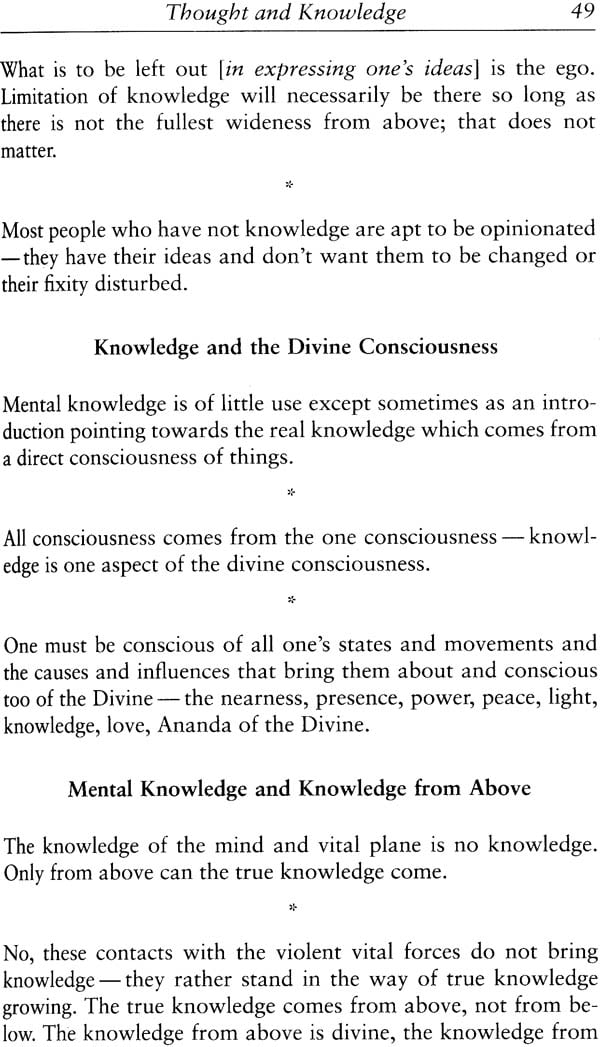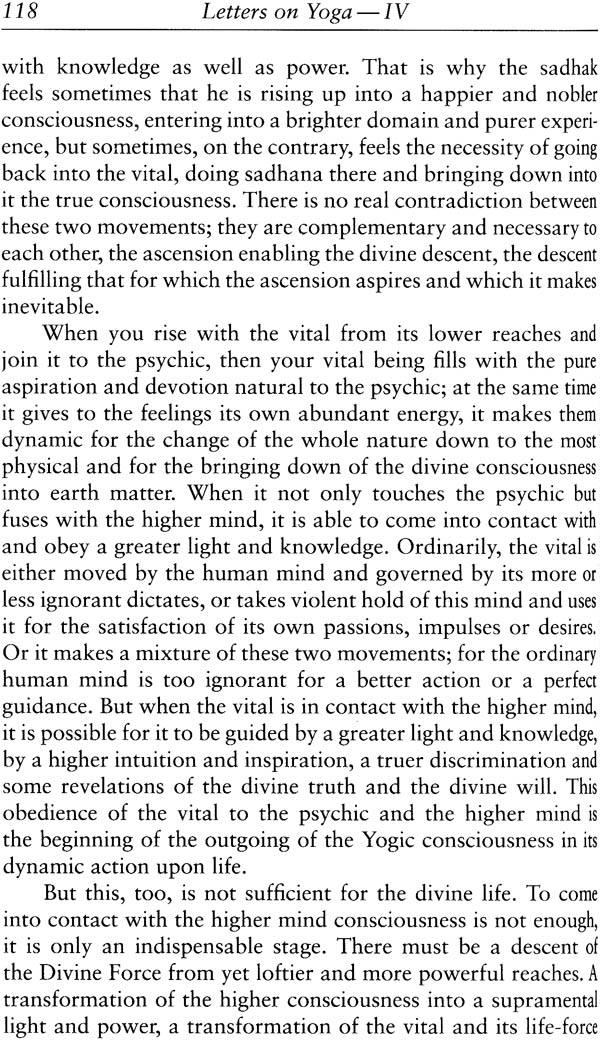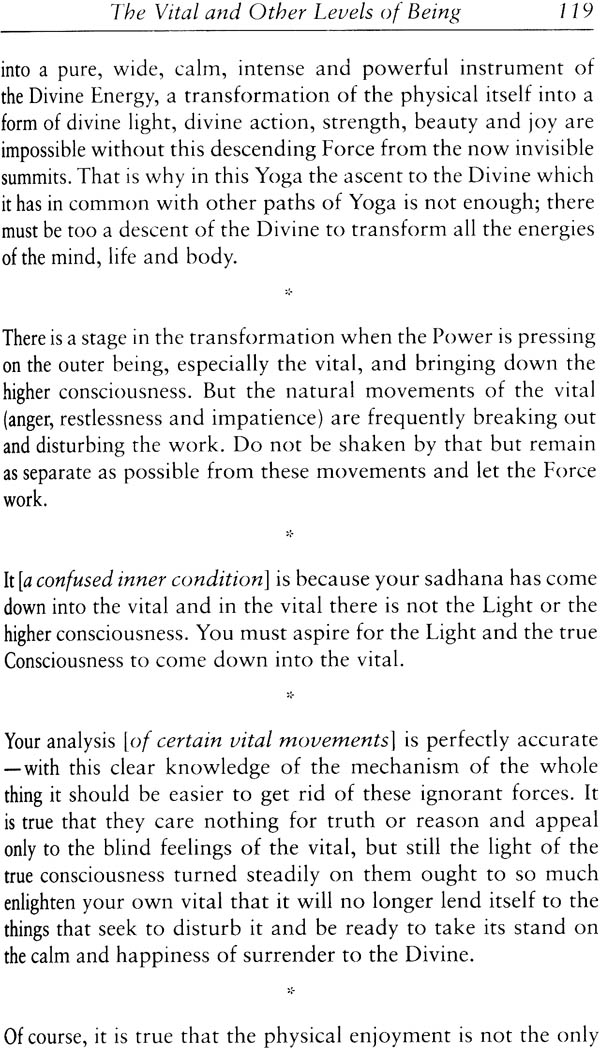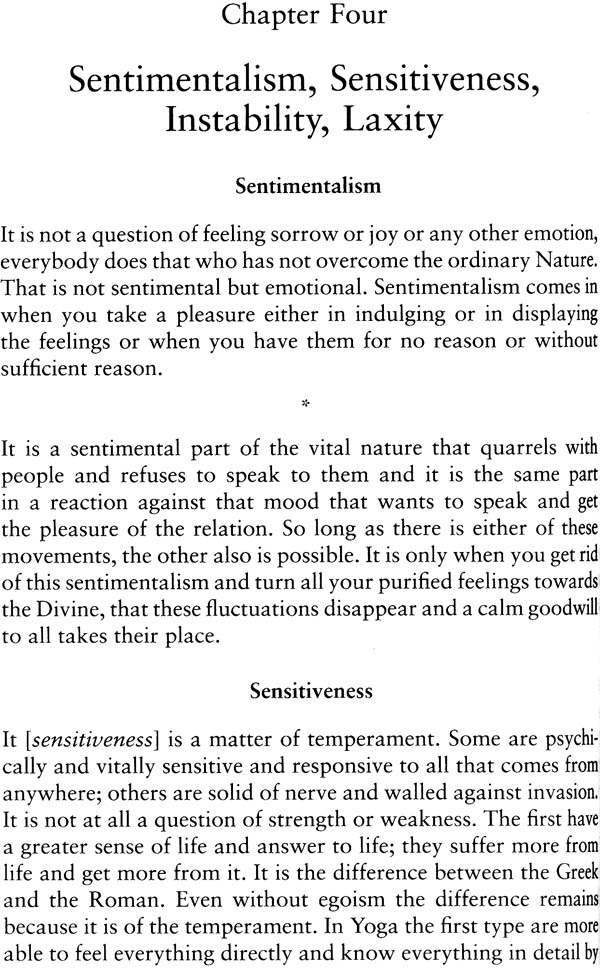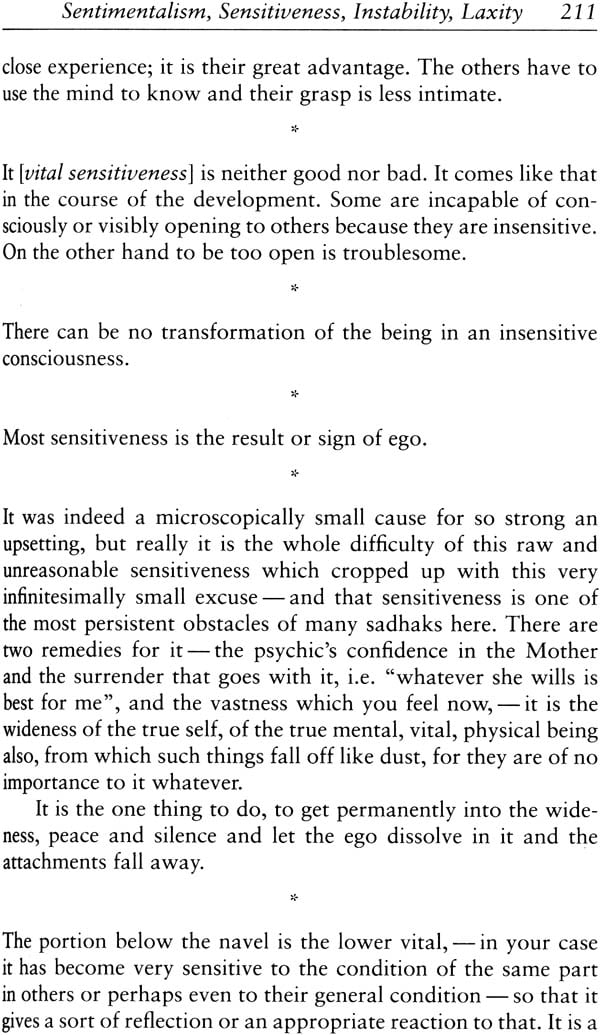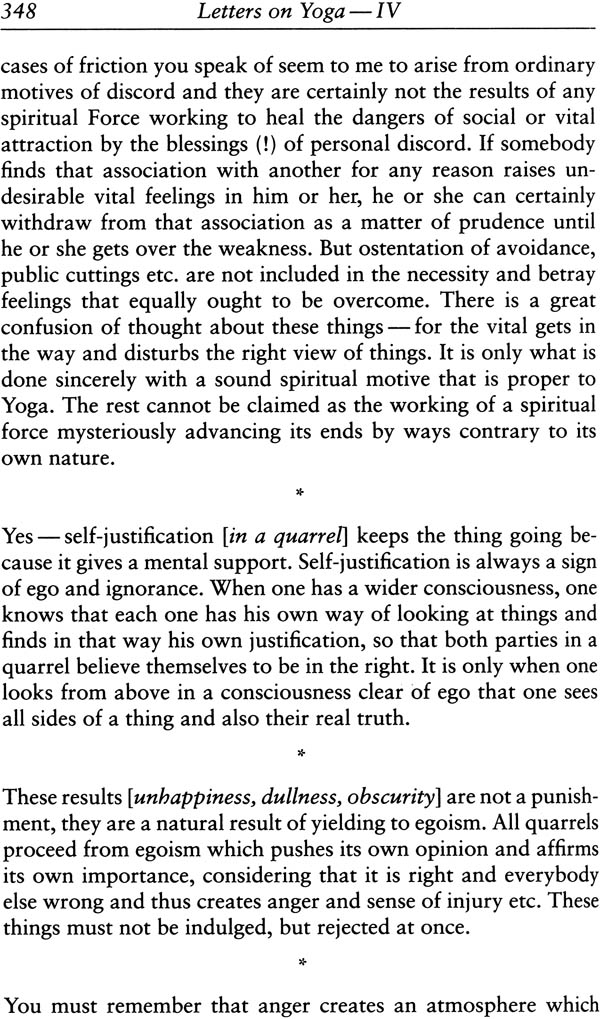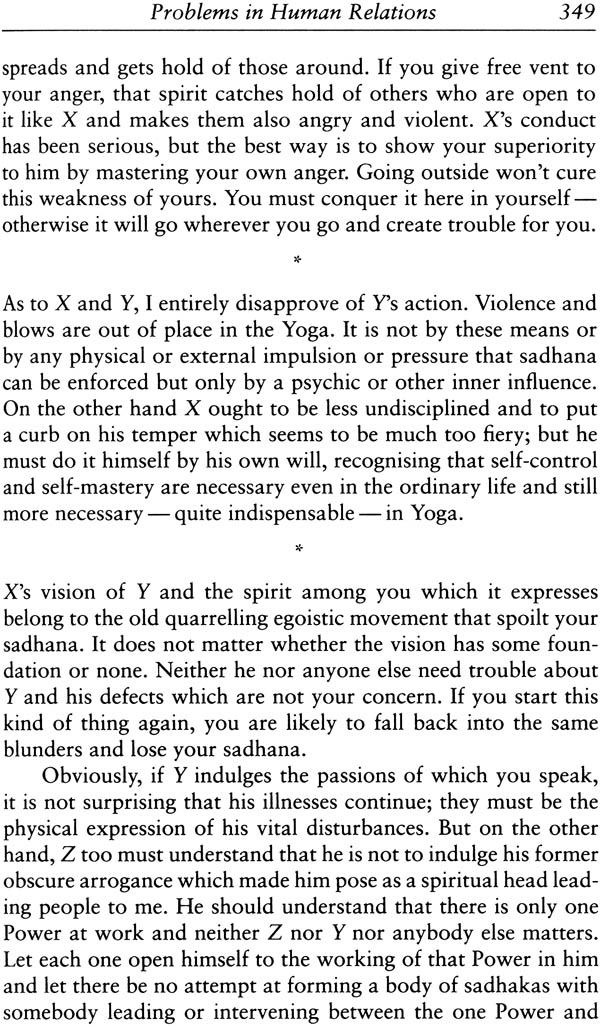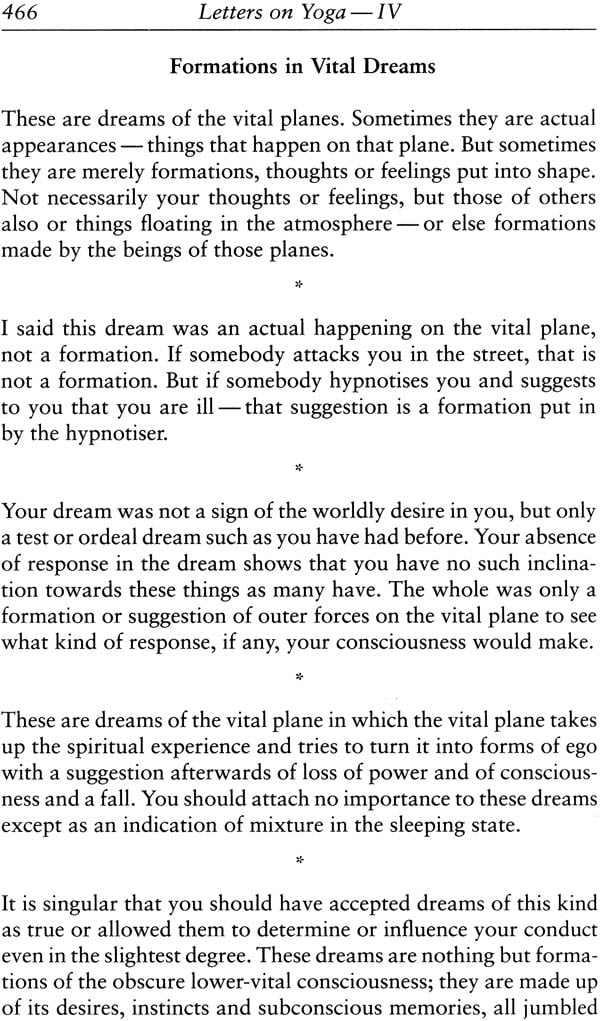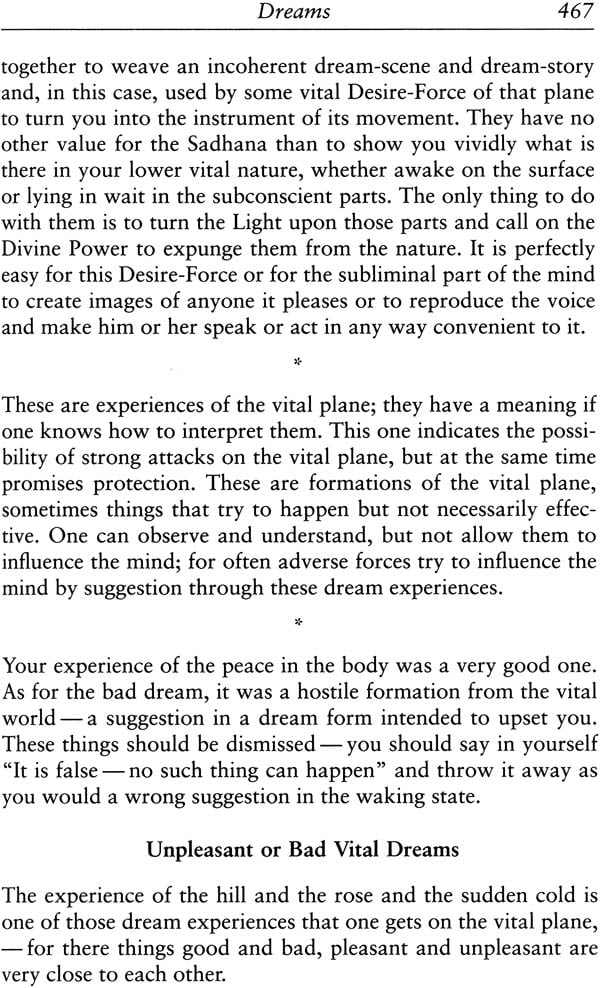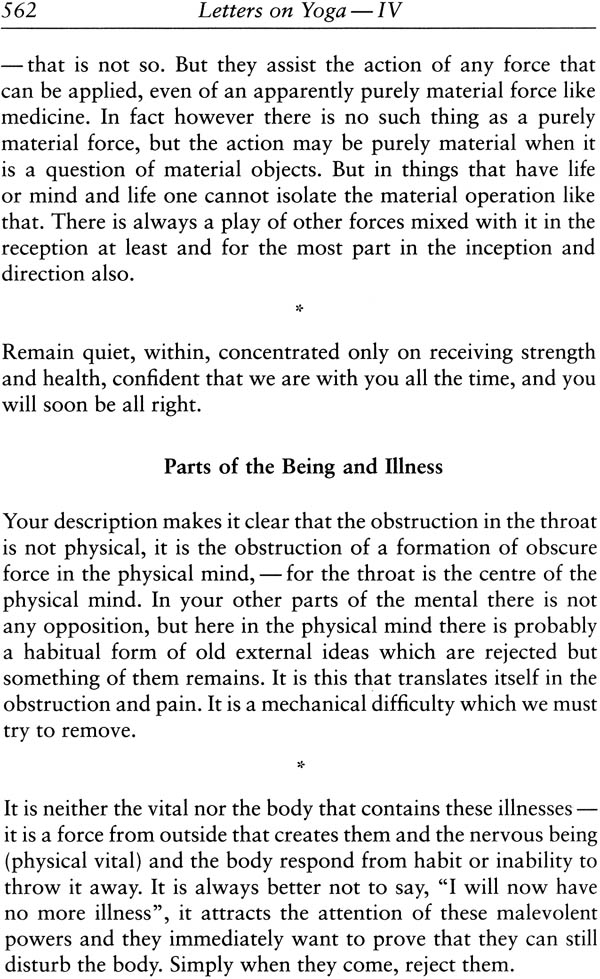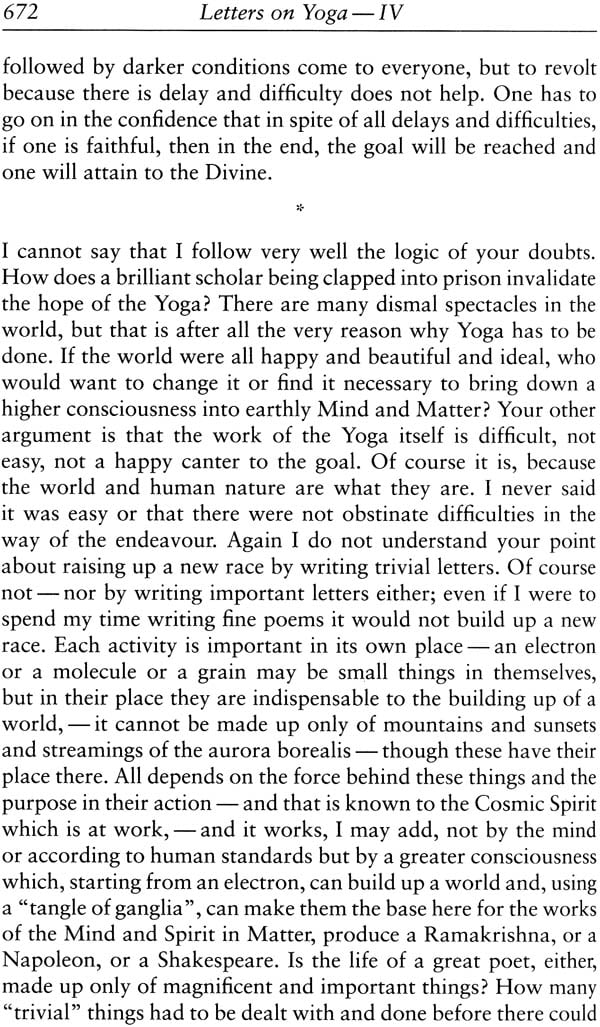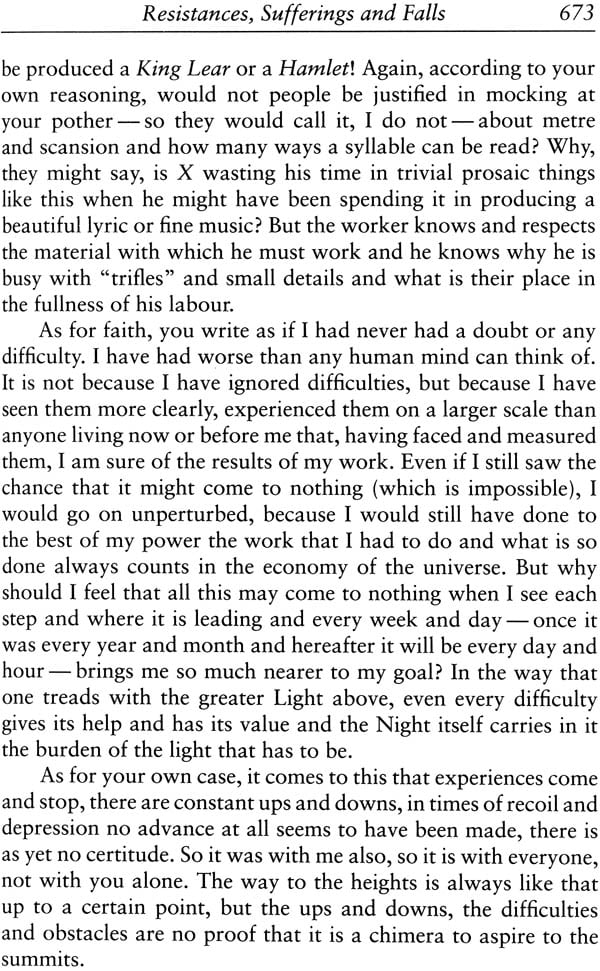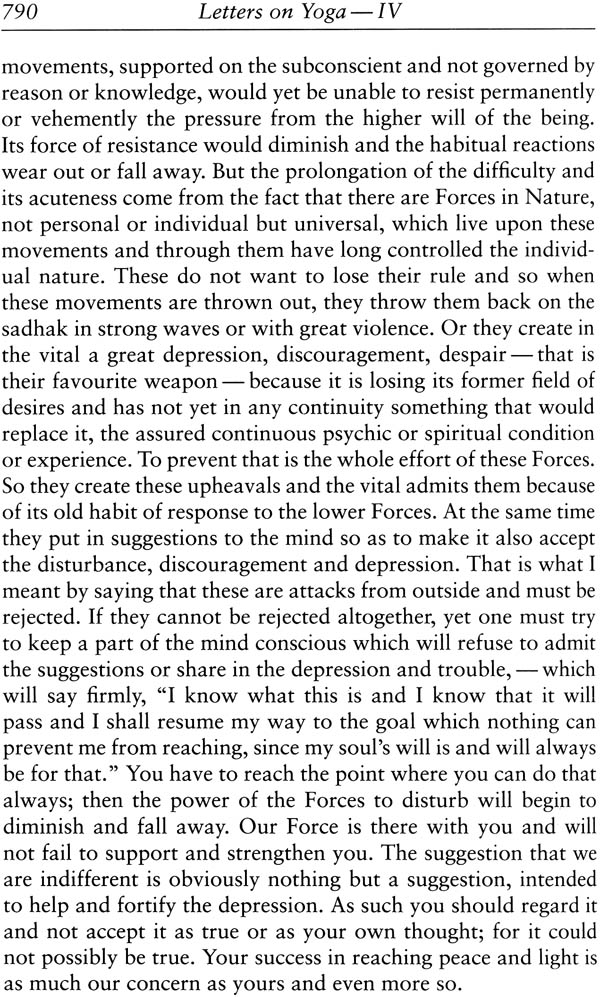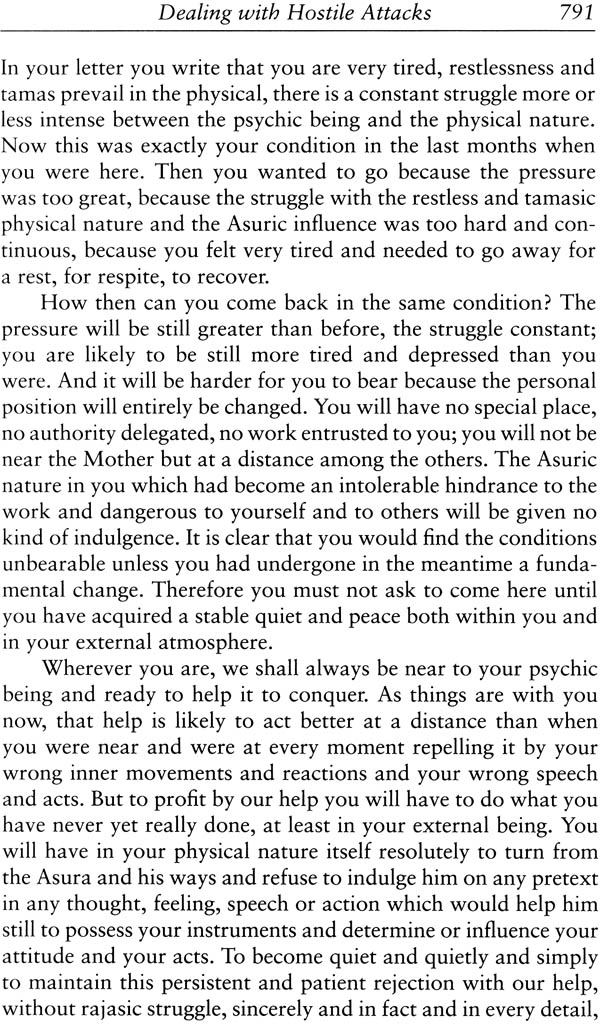
Letters on Yoga (Set of 4 Volumes)
Book Specification
| Item Code: | NAK732 |
| Author: | Sri Aurobindo |
| Publisher: | Sri Aurobindo Ashram |
| Language: | English |
| Edition: | 2021 |
| ISBN: | 9788170589532 |
| Pages: | 2520 |
| Cover: | Paperback |
| Other Details | 8.5 inch X 5.5 inch |
| Weight | 3.30 kg |
Book Description
Letters on Yoga – I contains letters of Sri Aurobindo on the philosophical and psychological foundations of the Integral Yoga. He wrote most of these letters in the 1930s to disciples living in his Ashram in Pondicherry. The main themes are:
The Divine, the cosmos and the individual
The parts of the being and the planes of consciousness
The evolutionary process and the Supermind
The place of the Divine Grace and the Guru in the Yoga
Problems of philosophy, science, religion and Society
Questions of spiritual and occult knowledge
“The faith in spiritual things that is asked of a sadhak is not an ignorant but a luminous faith, a faith in light and not in darkness. It is called blind by the sceptical intellect because it refuses to be guided by outer appearances or seeming facts, - for it looks to the truth behind, - and does not walk on the crutches of proof and evidence. It is an intuition, - an intuition not only waiting for experience to justify it, but leading towards experience. If I believe in self-healing, I shall after a time find out the way to heal myself – if I have faith in transformation, I can end by laying my hand on and unraveling the whole process of transformation. But if I being with doubt and go on with more doubt, how far am I likely to go on the journey?”
Sri Aurobindo was born in Calcutta on 15 August 1872. At the age of seven he was taken to England for his education. He studied at St. Paul’s School, London, and at King’s College, Cambridge. Returning to India in 1893, he worked for the next thirteen years in the Princely State of Baroda in the service of the Maharaja and as a professor in the State’s college.
In 1906 Sri Aurobindo quit his post in Baroda and went to Calcutta, where he became one of the leaders of the Indian nationalist movement. As editor of the newspaper Bande Mataram, he put forward the idea of complete independence from Britain. Arrested both for sedition and for treason, he was released for lack of evidence.
Sri Aurobindo began the practice of Yoga in 1905. Within a few years he achieved several fundamental spiritual realisation. In 1910 he withdrew from politics and went to Pondicherry in French India in order to concentrate on inner life and work. Over the next forty years, he developed a new spiritual path, the integral Yoga, whose ultimate aim is the transformation of life by the power of a supramental consciousness. In 1926, with the help of his spiritual collaborator the Mother, he founded the Sri Aurobindo Ashram. His vision of life is presented in numerous works of prose and poetry, among the best known of which are The Life Divine, The synthesis of Yoga, Essays on the Gita and Savitri. Sri Aurobindo passed away on 5 December 1950.
Letters on Yoga - I comprises letters written by Sri Aurobindo on the philosophical and psychological foundations of the Integral Yoga. It is the first of four volumes of Letters on Yoga, arranged by the editors as follows:
I. Foundations of the Integral Yoga
II. Practice of the Integral Yoga
III. Experiences and Realisations in the Integral Yoga
IV. Transformation of Human Nature in the Integral Yoga
The letters in these volumes have been selected from the large body of letters that Sri Aurobindo wrote to disciples and others between 1927 and 1950. Other letters from this period are published in Letters on Poetry and Art and Letters on Himself and the Ashram, volumes 27 and 35 of The Complete Works Sri Aurobindo. Letters written before 1927 are reproduced in Autobiographical Notes and Other Writings of Historical Interest, volume 36 of The Complete Works.
During Sri Aurobindo's lifetime, relatively few of his letters were published. Three small books of letters on Yoga were brought out in the 1930s. A more substantial collection came out between 1947 and 1951 in a four-volume series entitled Letters of Sri Aurobindo (including one volume of letters on poetry and literature). In 1958, many more letters were included in the two large tomes of On Yoga - II. A further expanded collection in three volumes entitled Letters on Yoga was published in 1970 as part of the Sri Aurobindo Birth Centenary Library. The present collection, also entitled Letters on Yoga, constitutes volumes 28-31 of The Complete Works. These volumes incorporate previously published letters and contain many new ones as well. About one-third of the letters in the present volume were not published in the Centenary Library.
The present volume is arranged by subject in five parts:
1. The Divine, the Cosmos and the Individual
2. The Parts of the Being and the Planes of Consciousness
3. The Evolutionary Process and the Supermind
4. Problems of Philosophy, Science, Religion and Society
5. Questions of Spiritual and Occult Knowledge
| Part One | The Divine, The Cosmos And The Individual | |
| Section One | The Divine, Sachidananda, Brahman and Atman | |
| The Divine and Its Aspects | 5-12 | |
| Sachidananda: Existence, Consciousness-force and Bliss | 13-27 | |
| Brahma | 28-29 | |
| The Self or Atman | 30-32 | |
| Section Two | The Cosmos: Terms from India Systems | |
| The Upanisadic and Puranic Systems | 37-39 | |
| The Sankhya-Yoga System | 40-51 | |
| Section Three | The Jivatman and the Psychic Being | |
| The Jivatman in the Integral Yoga | 55-66 | |
| The Jivatman in Other Indian Systems | 68 | |
| Part Two | The Parts of The Being And The Planes of Consciousness | |
| Section One | The Organisation of the Being | |
| The Parts of the Being | 79-80 | |
| Classification of the Parts of the Being | 82 | |
| Section Two | The Concentric System: Outer to Inner | |
| The Outer Being and the Inner Being | 89-95 | |
| The True Being and the True Consciousness | 97-99 | |
| The Psychic Being | 102-124 | |
| Section Three | The Vertical System: Supermind to Subconscient | |
| The Planes or Worlds of Consciousness | 127-132 | |
| The Supermind or Supramental | 133-151 | |
| The Overmind | 152-156 | |
| The Higher Planes of Mind | 158-164 | |
| The Lower Nature of Lower Hemisphere | 166-167 | |
| The Mind | 168-184 | |
| The Vital Being and Vital Consciousness | 185-198 | |
| The Physical Consciousness | 200-212 | |
| The Environmental Consciousness | 213-215 | |
| The Subconscient and the Inconscient | 216-225 | |
| Section Four | The Chakras or Centres of Consciousness | |
| The System of the Chakras | 229-244 | |
| The Parts of the Body and the Centres | 245-247 | |
| Part Three | The Evolutionary Process and The Supermind | |
| Section One | The Supramental Evolution | |
| The Problem of Suffering and Evil | 253-262 | |
| Spiritual Evolution and the Supramental | 265-280 | |
| Section Two | The Supramental Descent and Transformation | |
| The Descent of the Supermind | 287-292 | |
| Descent and Transformation | 294-299 | |
| The Supermental Transformation | 301-303 | |
| Transformation and the Body | 305-315 | |
| Part Four | Problems of Philosophy, Science, Religion And Society | |
| Section One | Thought, Philosophy, Science and Yoga | |
| The Intellect and Yoga | 321-330 | |
| Doubt and Faith | 337-348 | |
| Philosophical Thought and Yoga | 351-375 | |
| Science and Yoga | 380-408 | |
| Section Two | Religion, Idealism, Morality and Yoga | |
| Religion and Yoga | 411-415 | |
| Idealism and Spirituality | 416-417 | |
| Morality and Yoga | 419-437 | |
| Social Duties and the Divine | 438-444 | |
| Part Five | Questions Of Spiritual And Occult Knowledge | |
| Section One | The Divine and the Hostile Powers | |
| Terminology | 449-450 | |
| The Gods | 456-459 | |
| The Hostile Forces and Hostile Beings | 461-463 | |
| Section Two | The Avatar and the Vibhuti | |
| The Meaning and Purpose of Avatarhood | 471-485 | |
| Specific Avatars and Vibhutis | 487-502 | |
| Human Greatness | 504-505 | |
| Section Three | Destiny, Karma, Death and Rebirth | |
| Fate, Free Will and Prediction | 509-519 | |
| Karma and Heredity | 520-522 | |
| Death | 526-529 | |
| Rebirth | 532-554 | |
| Section Four | Occult Knowledge and Powers | |
| Occult Knowledge | 559-569 | |
| Occult Powers or Siddhis | 571-580 | |
| Note on The Texts | 581 |
Letters on Yoga-II contains letters of Sri Aurobindo on the practice of his system of Yoga. He wrote most of these letters in the 1930s to disciples living in his Ashram in Pondicherry. The main themes are:
The aim of the Integral Yoga
The qualities needed to practice this Yoga
The foundation of peace and equality
The place of the Divine Grace and the Guru
The synthetic method of knowledge, works devotion and self-perfection
The differences between this Yoga and other spiritual paths
“To find the Divine is indeed the first reason for seeking the spiritual Truth and the spiritual life; it is the one thing indispensable and all the rest is nothing without it. We must find the Self, the Divine, then only can we know what is the work the Self or the Divine demands from us. Until then our life and action can only be a help or means towards finding the Divine and it ought not to have any other purpose.”
Letters on Yoga - II comprises letters written by Sri Aurobindo on the philosophical and psychological foundations of the Integral Yoga. It is the first of four volumes of Letters on Yoga, arranged by the editors as follows:
I. Foundations of the Integral Yoga
II. Practice of the Integral Yoga
III. Experiences and Realisations in the Integral Yoga
IV. Transformation of Human Nature in the Integral Yoga
The letters in these volumes have been selected from the large body of letters that Sri Aurobindo wrote to disciples and others between 1927 and 1950. Other letters from this period are published in Letters on Poetry and Art and Letters on Himself and the Ashram, volumes 27 and 35 of The Complete Works Sri Aurobindo. Letters written before 1927 are reproduced in Autobiographical Notes and Other Writings of Historical Interest, volume 36 of The Complete Works.
During Sri Aurobindo's lifetime, relatively few of his letters were published. Three small books of letters on Yoga were brought out in the 1930s. A more substantial collection came out between 1947 and 1951 in a four-volume series entitled Letters of Sri Aurobindo (including one volume of letters on poetry and literature). In 1958, many more letters were included in the two large tomes of On Yoga - II. A further expanded collection in three volumes entitled Letters on Yoga was published in 1970 as part of the Sri Aurobindo Birth Centenary Library. The present collection, also entitled Letters on Yoga, constitutes volumes 28-31 of The Complete Works. These volumes incorporate previously published letters and contain many new ones as well. About one-third of the letters in the present volume were not published in the Centenary Library.
The present volume is arranged by subject in three parts:
1. The Path of the Integral Yoga
2. The Synthetic Method of the Integral Yoga
3. The Integral Yoga and Others Spiritual Paths
| Part One | The Path of The Integral Yoga | |
| Section One | The Path and the Goal | |
| Seeking the Divine | 5-15 | |
| The Aim of the Integral Yoga | 19-23 | |
| Section Two | Basic Requisites of the Path | |
| The Call and the Capacity | 27-36 | |
| Qualities Needed for Sadhana | 42-43 | |
| Purity | 46-48 | |
| Sincerity | 50-54 | |
| Aspiration | 55-63 | |
| Rejection | 64 | |
| Surrender | 67-82 | |
| Faith | 88-101 | |
| Consecration and Offering | 103-104 | |
| Opening | 105-106 | |
| Patience and Perseverance | 110-118 | |
| Vigilance | 119 | |
| Section Three | The Foundation of the Sadhana | |
| Peace - The Basis of the Sadhana | 123-125 | |
| Equality - The Chief Support | 129-134 | |
| Quiet and Calm | 137-145 | |
| Peace | 148-156 | |
| Silence | 158-162 | |
| Section Four | ||
| The Divine Response | ||
| The Divine Grace and Guidance | 167-175 | |
| The Divine Force | 179-188 | |
| The Guru | 190-200 | |
| Part Two | The Synthetic Method of the Integral Yoga | |
| Section One | A Yoga of Knowledge, Works, Bhakti and Self-Perfection | |
| The Central Processes of the Sadhana | 207-215 | |
| Combining Work, Meditation and Bhakti | 216-227 | |
| Section Two | Sadhana through Work | |
| Work and Yoga | 231-253 | |
| Becoming Conscious in Work | 254-264 | |
| The Divine Force in Work | 266-274 | |
| Practical Concerns in Work | 276-287 | |
| Creative Activity | 290-294 | |
| Section Three | Sadhana through Concentration, Meditation and Japa | |
| Concentration and Meditation | 297-319 | |
| Mantra and Japa | 322-328 | |
| Section Four | Sadhana through Love and Devotion | |
| Divine Love, Psychic Love and Human Love | 333-347 | |
| Bhakti, Devotion, Worship | 350-365 | |
| Part Three | The Integral Yoga and Other Spiritual Paths | |
| Section One | A Yoga of Transformation | |
| Distinctive Features of the Integral Yoga | 373-379 | |
| Asceticism and the Integral Yoga | 380-387 | |
| A Realistic Adwaita | 391- | |
| Transformation in the Integral Yoga | 398-407 | |
| Section Two | Other Spiritual Paths and the Integral Yoga | |
| The Newness of the Integral Yoga | 411-416 | |
| The Veda and the Upanishads | 417-425 | |
| Jainism and Buddhism | 428-434 | |
| Sankhya and Yoga | 437-439 | |
| The Yoga of the Bhagavad Gita | 441-444 | |
| The Adwaita of Shankaracharya | 447-457 | |
| Tantra | 459-464 | |
| Bhakti Yoga and Vaishnavism | 465-494 | |
| The Teachings of Some Modern Indian Yogis | 496-500 | |
| Christianity and Theosophy | 504-511 | |
| Note on The Texts | 515 |
Letters on Yoga-III contains letters of Sri Aurobindo on the experiences and realizations that may occur in the practice of his system of Yoga. He wrote most of these letters in the 1930s to disciples living in his Ashram in Pondicherry. The main themes are:
The place of experiences in the Integral Yoga
The movement inward, the opening of the inner senses, and the discovery of the inner being
The finding of the psychic being or soul
Widening into the cosmic consciousness
The movement upward to experience the Self, the One, and the Infinite
The movement of ascent and descent to bring about the spiritual transformation
“Letters to live within, to act always from within, from constant inner communion with the Mother. It may be difficult at first to do it always and completely, but it can be done if one sticks to it – and it is at that price, by learning to do that that one can have the siddhi in the Yoga.”
Letters on Yoga - III comprises letters written by Sri Aurobindo on the philosophical and psychological foundations of the Integral Yoga. It is the first of four volumes of Letters on Yoga, arranged by the editors as follows:
I. Foundations of the Integral Yoga
II. Practice of the Integral Yoga
III. Experiences and Realisations in the Integral Yoga
IV. Transformation of Human Nature in the Integral Yoga
The letters in these volumes have been selected from the large body of letters that Sri Aurobindo wrote to disciples and others between 1927 and 1950. Other letters from this period are published in Letters on Poetry and Art and Letters on Himself and the Ashram, volumes 27 and 35 of The Complete Works Sri Aurobindo. Letters written before 1927 are reproduced in Autobiographical Notes and Other Writings of Historical Interest, volume 36 of The Complete Works.
During Sri Aurobindo's lifetime, relatively few of his letters were published. Three small books of letters on Yoga were brought out in the 1930s. A more substantial collection came out between 1947 and 1951 in a four-volume series entitled Letters of Sri Aurobindo (including one volume of letters on poetry and literature). In 1958, many more letters were included in the two large tomes of On Yoga - II. A further expanded collection in three volumes entitled Letters on Yoga was published in 1970 as part of the Sri Aurobindo Birth Centenary Library. The present collection, also entitled Letters on Yoga, constitutes volumes 28-31 of The Complete Works. These volumes incorporate previously published letters and contain many new ones as well. About one-third of the letters in the present volume were not published in the Centenary Library.
The present volume is arranged by subject in four parts:
1. The Place of Experiences in the Practice of Yoga
2. The Opening of the Inner Sense
3. Experiences of the Inner Consciousness and the Cosmic Consciousness
4. The Fundamental Realisations of the Integral Yoga
| Part One | The Place of Experiences In The Practice of Yoga | |
| Section One | The Nature and Value of Experiences | |
| Experiences and Realisations | 5-12 | |
| The Value of Experiences | 13-14 | |
| Inner Experience and Outer Life | 21-26 | |
| The Danger of the Ego and the Need of Purification | 29-44 | |
| Suggestions for Dealing with Experiences | 47-52 | |
| Section Two | Vicissitudes on the Way to Realisation | |
| Variations in the Intensity of Experience | 57-70 | |
| Emptiness, Voidness, Blankness and Silence | 72-81 | |
| Part Two | The Opening of The Inner Senses | |
| Section One | Visions, Sounds, Smells and Tastes | |
| The Value of Visions | 87-97 | |
| Kinds of Vision | 98-108 | |
| Subtle Sights, Sounds, Smells and Tastes | 111-113 | |
| Section Two | Lights and Colours | |
| Light | 117-120 | |
| Colours | 122-134 | |
| Section Three | Symbols | |
| Symbols and Symbolic Visions | 137-139 | |
| Sun, Moon, Star, Fire | 142-147 | |
| Sky, Weather, Night and Drawn | 148-149 | |
| Water and Bodies of Water | 150-151 | |
| Earth | 152-153 | |
| Gods, Goddesses and Semi-Divine Beings | 155-159 | |
| The Human World | 160-164 | |
| The Animal World | 165-176 | |
| The Plant World | 177-180 | |
| Constructions | 181-181 | |
| Objects | 183-187 | |
| Numbers and Letters | 188-188 | |
| Part Three | Experiences of the Inner Consciousness and the Cosmic Consciousness | |
| Section One | Experiences on the Inner Planes | |
| Experiences on the Subtle Physical, Vital and Mental Planes | 193-203 | |
| Exteriorisaton or Going Out of the Body | 205-206 | |
| Section Two | Experiences of the Inner Being and the Inner Consciousness | |
| The Inward Movement | 211-236 | |
| Inner Detachment and the Witness Attitude | 238-246 | |
| Inner Experiences in the State of Samadhi | 248-256 | |
| Three Experiences of the Inner Being | 257-262 | |
| Section Three | Experiences of the Cosmic Consciousness | |
| The Universal or Cosmic Consciousness | 267-279 | |
| Aspects of the Cosmic Consciousness | 281-285 | |
| The Universal or Cosmic Forces | 287-290 | |
| Section Four | The Dangers of Inner and Cosmic Experiences | |
| The Intermediate Zone | 295-306 | |
| Inner Voices and Indications | 308-309 | |
| Part Four | The Fundamental Realisations of the Integral Yoga | |
| Section One | Three Stages of Transformation: Psychic, Spiritual, Supramental | |
| The Psychic and Spiritual Realisations | 319-323 | |
| Conditions of Transformation | 331-333 | |
| Section Two | The Psychic Opening, Emergence and Transformation | |
| The Psychic Being and Its Role in Sadhana | 337-344 | |
| The Psychic Opening | 347-352 | |
| The Emergence or Coming Forward of the Psychic | 354-362 | |
| Experiences Associated with the Psychic | 367-378 | |
| The Psychic and Spiritual Transformations | 380-387 | |
| Section Three | Spiritual Experiences and Realisations | |
| Experiences of the Self, the One and the Infinite | 391-399 | |
| Experiences on the Higher Planes | 401-411 | |
| Section Four | The Spiritual Transformation | |
| Ascent and Descent | 415-425 | |
| Ascent to the Higher Planes | 428-439 | |
| The Descent of the Higher Consciousness and Force | 441-447 | |
| The Descent of the Higher Powers | 449-462 | |
| Descent and Other Kinds of Experience | 463-466 | |
| Feelings and Sensations in the Process of Descent | 469-477 | |
| Difficulties Experienced in the Process of Descent | 479-485 | |
| Descent and the Lower Nature | 487-497 | |
| Note on The Texts | 499 |
Letters on Yoga – IV contains letters of Sri Aurobindo on the transformation of human nature – mental, vital and physical – through the practice of Integral Yoga. It also contains letters on the difficulties encountered in practising this Yoga. Most of these letters were written by Sri Aurobindo in the 1930s to disciples living in his Ashram in Pondicherry. The main themes are:
Sadhana on the level of the mind: mental difficulties; cultivation of the mind; power of expression; speech
Sadhana on the level of the vital: the vital nature; vital temperament and vital defects; human relations and interactions
Sadhana on the physical, subconscient and inconscient levels: transformation of the physical; food, sleep, dreams and sex; illness doctors and medicines
Difficulties in the practice of Yoga: kinds of difficulty, overcoming difficulties, the opposition of the hostile Forces
“It is the lesson of life that always in this world everything fails a man – only the Divine does not fail him, if he turns entirely to the Divine. It is not because there is something bad in you that blows fall on you, - blows fall on all human beings because they are full of desire for things that cannot last and they lose them or, even if they get, it brings disappointment and cannot satisfy them. To turn to the Divine is the only truth in life.”
Letters on Yoga - IV comprises letters written by Sri Aurobindo on the philosophical and psychological foundations of the Integral Yoga. It is the first of four volumes of Letters on Yoga, arranged by the editors as follows:
I. Foundations of the Integral Yoga
II. Practice of the Integral Yoga
III. Experiences and Realisations in the Integral Yoga
IV. Transformation of Human Nature in the Integral Yoga
The letters in these volumes have been selected from the large body of letters that Sri Aurobindo wrote to disciples and others between 1927 and 1950. Other letters from this period are published in Letters on Poetry and Art and Letters on Himself and the Ashram, volumes 27 and 35 of The Complete Works Sri Aurobindo. Letters written before 1927 are reproduced in Autobiographical Notes and Other Writings of Historical Interest, volume 36 of The Complete Works.
During Sri Aurobindo's lifetime, relatively few of his letters were published. Three small books of letters on Yoga were brought out in the 1930s. A more substantial collection came out between 1947 and 1951 in a four-volume series entitled Letters of Sri Aurobindo (including one volume of letters on poetry and literature). In 1958, many more letters were included in the two large tomes of On Yoga - II. A further expanded collection in three volumes entitled Letters on Yoga was published in 1970 as part of the Sri Aurobindo Birth Centenary Library. The present collection, also entitled Letters on Yoga, constitutes volumes 28-31 of The Complete Works. These volumes incorporate previously published letters and contain many new ones as well. About one-third of the letters in the present volume were not published in the Centenary Library.
The present volume is arranged by subject in four parts:
1. Sadhana on the Level of the Mind
2. Sadhana on the Level of the Vital
3. Sadhana on the Physical, Subconscient and Inconscient Levels
4. Difficulties in the Practice of the Integral Yoga
| Part One | Sadhana on the Level of the Mind | |
| Section One | The Mind and Sadhana | |
| The Mind and Other Levels of Being | 5-9 | |
| Intellect and the Intellectual | 11-18 | |
| Mental Difficulties and the Need of Quietude | 20-27 | |
| The Physical Mind and Sadhana | 30-39 | |
| Thought and Knowledge | 40-56 | |
| Section Two | Cultivation of the Mind in Yoga | |
| Mental Development and Sadhana | 59-65 | |
| The Place of Study in Sadhana | 69-75 | |
| The Power of Experession and Yoga | 76-78 | |
| Speech and Yoga | 80-94 | |
| Part Two | Sadhana on the Level of the Vital | |
| Section One | The Vital Being and Sadhana | |
| The Nature of the Vital | 101-114 | |
| The Vital and Other Levels of Being | 116-127 | |
| Wrong Movements of the Vital | 129-148 | |
| The Lower Vital Being | 150-169 | |
| Section Two | Vital Temperament | |
| Cheerfulness and Happiness | 173-175 | |
| Sorrow and Suffering | 177-180 | |
| Depression and Despondency | 182-206 | |
| Sentimentalism, Sensitiveness, Instability, Laxity | 210-214 | |
| Section Three | Vital Defects | |
| Ego and Its Forms | 217-250 | |
| Desire | 251-264 | |
| Anger and Violence | 267-279 | |
| Fear | 278 | |
| Section Four | Human Relations in Yoga | |
| Human Relations and the Spiritual Life | 283-310 | |
| Interactions with Others and the Practice of Yoga | 312-344 | |
| Problems in Human Relations | 346-352 | |
| Part Three | Sadhana on the Physical, Subconscient and Inconscient Levels | |
| Section One | Sadhana on the Level of the Physical | |
| The Transformation of the Physical | 359-367 | |
| Levels of the Physical Being | 372-387 | |
| Difficulties of the Physical Nature | 388-415 | |
| Section Two | Food, Sleep, Dreams and Sex | |
| Food | 419-435 | |
| Sleep | 437-452 | |
| Dreams | 455-477 | |
| Sex | 485-545 | |
| Section Three | Illness, Doctors and Medicines | |
| Illness and Health | 549-575 | |
| Doctors and Medicines | 578-584 | |
| Specific Illness, Ailments and Other Physical Problems | 586-590 | |
| Section Four | The Subconscient and the Inconscient and the Process of Yoga | |
| The Subconscient and the Integral Yoga | 595-612 | |
| The Inconscient and the Integral Yoga | 617 | |
| Part Four | Difficulties in the Practice of the Integral Yoga | |
| Section One | Difficulties of the Path | |
| The Difficulties of Yoga | 625-635 | |
| The Difficulties of Human Nature | 638-653 | |
| Imperfections and Periods of Arrest | 655-663 | |
| Resistances, Sufferings and Falls | 667-674 | |
| Section Two | Overcoming the Difficulties of Yoga | |
| The Right Attitude towards Difficulties | 681-694 | |
| Steps towards Overcoming Difficulties | 696-699 | |
| Vigilance, Resolution, Will and the Divine Help | 709-724 | |
| Time and Change of the Nature | 726-732 | |
| Dealing with Despression and Despondency | 734-747 | |
| Section Three | The Opposition of the Hostile Forces | |
| The Hostile Forces and the Difficulties of Yoga | 757-768 | |
| Attacks by the Hostile Forces | 769-780 | |
| Dealing with Hostile Attacks | 782-797 | |
| Accidents, Possession, Madness | 800-806 | |
| Note on The Texts | 813 |
